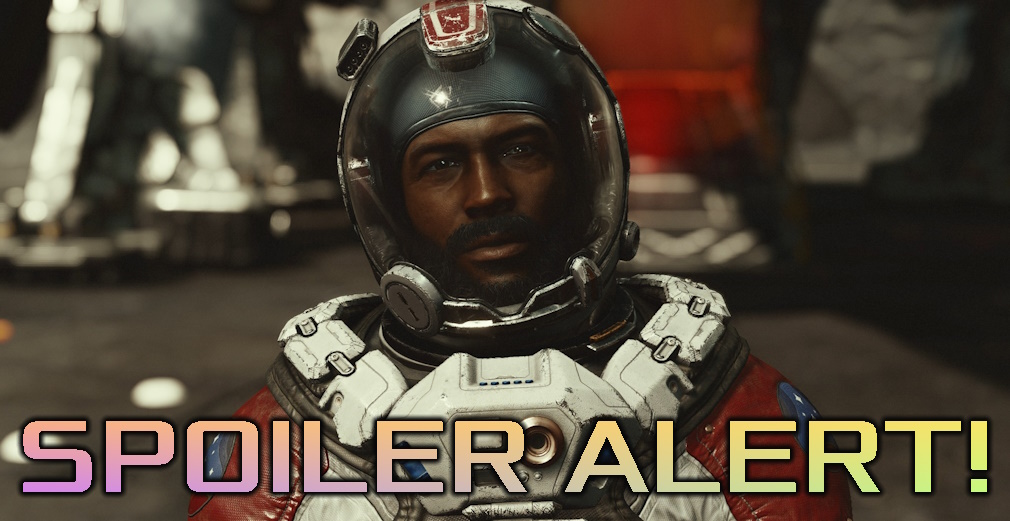
Spoiler Warning: While there are no major story spoilers for Starfield, minor spoilers for the main quest and a handful of side-quests are present.
I promised that I’d share my first impressions of Starfield as soon as possible, and with the game finally launching for us plebs who didn’t fork over £100 to get “early” access, I’ve belatedly had the chance to jump in and try it for myself. I’m basing my impressions of the game on approximately twenty hours of playtime, in which I’ve started but not completed the main quest, created a character, worked on my spaceship, undertaken a handful of side-missions and fetch quests, and landed on about twenty different planets. There’s no way I can reasonably “review” a game as large and long as Starfield without beating a single questline, so I’m calling this piece my “first impressions” of the game.
Starfield’s showcase earlier this summer was fantastic, and the game rocketed up the list to become my most-anticipated launch of the year. The idea of playing an open-galaxy adventure with all of the fantastic writing and quest design of a Bethesda game combined with spaceflight, spaceship building, and exploration, and set in a new fictional universe with designs that drew inspiration from NASA… it all seemed too good to be true. A friend of mine suggested to me a couple of months ago that Starfield “might be the best game that either of us will ever play.” Try as I might to avoid the hype, there’s no denying how excited I was for Starfield.
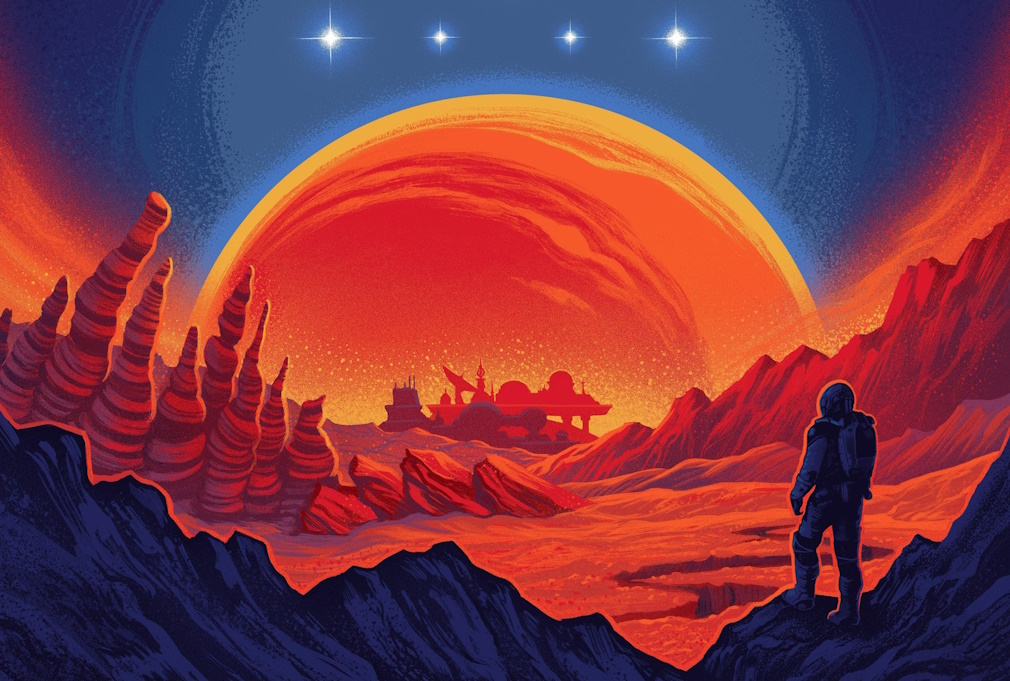
Hype can be detrimental to any game if not properly handled, something I commented on shortly before the release of 2020’s Cyberpunk 2077. I said then that games publishers and their marketing teams need to do a better job at reining in speculation, and that there are ways to let players down gently, redirecting the conversation, if necessary, away from features that won’t be part of a game. The hype train for Starfield definitely got unwieldy, and I fear that Bethesda ended up over-promising.
Let’s get the headline out of the way right now: Starfield is undeniably a good game… but it doesn’t always make good on some of its loftier promises and ambitions. It brings a lot to the table, but several of its key features and systems feel barebones and underdone, especially when compared to other titles in a similar space, meaning that there’s not a lot to offer in terms of longer-term play or replayability. Thus far, the game’s main story has failed to grab me following what I felt was a pretty rushed beginning, and customisation options for both the player character and their spaceship aren’t at the level I was hoping for. There are also some notable bugs that slipped through, in spite of promises that Starfield would be Bethesda’s “least-buggy release ever,” and graphics that feel outdated in some areas.
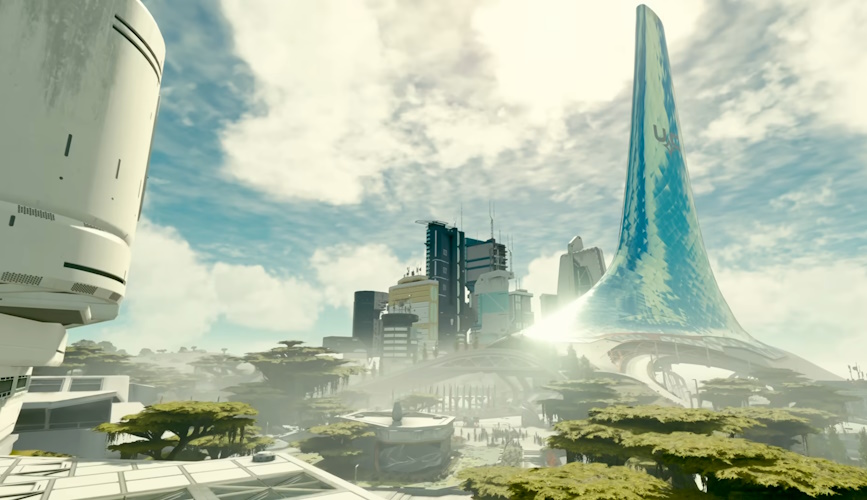
That being said, Starfield gets a lot right. The game’s art style and overall aesthetic is exactly what I was looking for, drawing on real-world space agencies like NASA and retro sci-fi properties from the ’70s and ’80s that I grew up with. There’s some genuinely enjoyable gunplay – a first for a Bethesda title. Voice acting is solid across the board. And while I don’t feel that the game has really managed to suck me in – at least, not yet – it still manages to evoke at least some of those feelings of being a space captain in a sci-fi world that it was aiming for.
I think the best thing to do at this point is to break this article into segments. Each segment will tackle one aspect of Starfield’s gameplay, and then we’ll bring it all together at the end for a conclusion. I’ll try to avoid major plot spoilers – though I’m yet to complete the main quest or any faction questline, so there shouldn’t be anything massive in the mix.
Exploration:
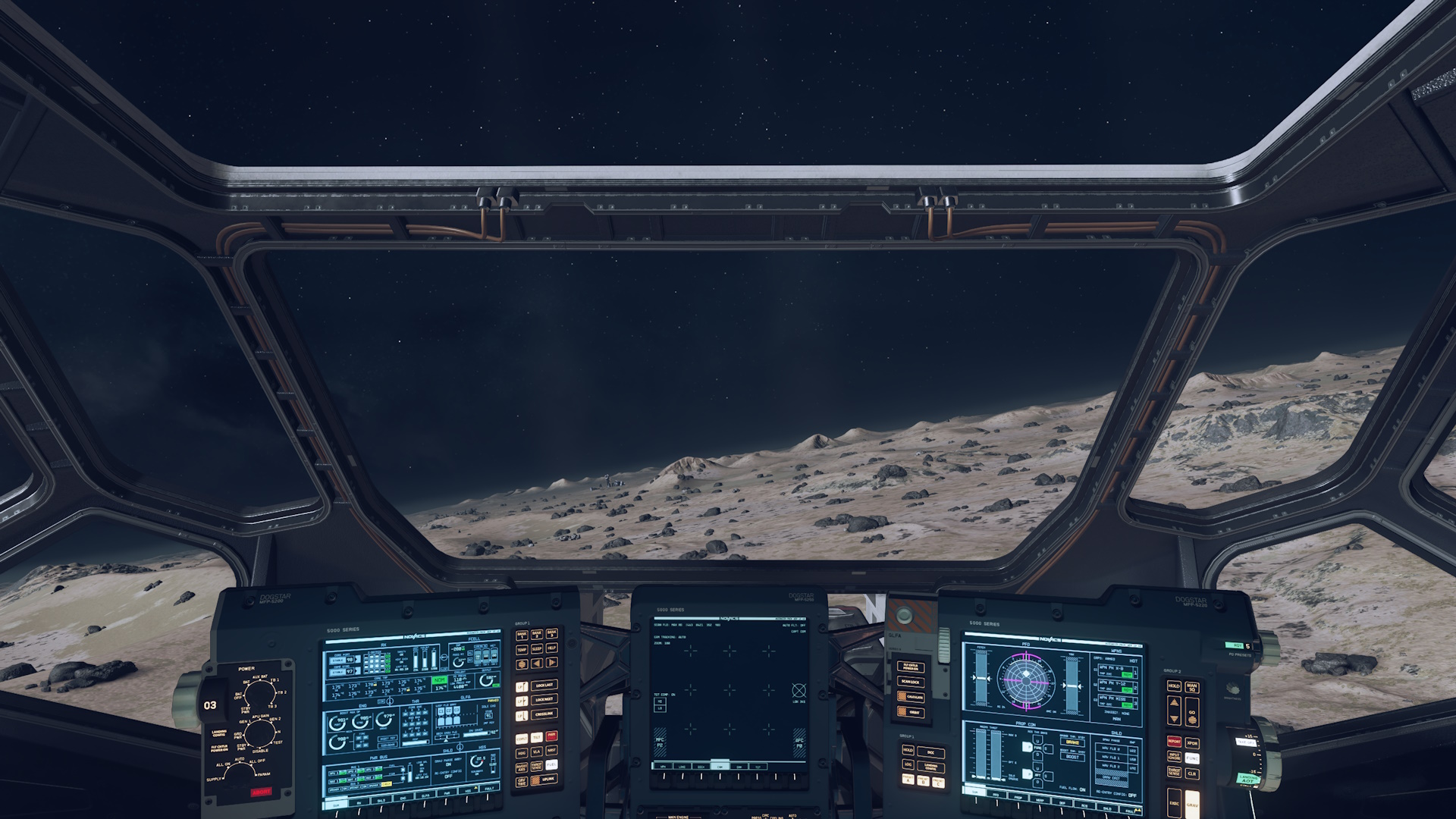
Exploring in Starfield is not what I expected it would be. After landing on the surface of a planet, you’re restricted to a “landing zone” that takes about ten to twelve minutes to reach the boundary of while traversing on foot. No, despite what you may have heard, a landing zone is not “the same size as Skyrim!” For the most part, I don’t think the size of a landing zone is a particular problem, and I’d wager that most players – though by no means all – won’t bother to trek as far as the invisible wall. But that in itself is saying something – because there’s not a lot to do in a lot of these places, and much of what is on offer gets repetitive very quickly.
As an aside about invisible walls: this could have been handled better. An in-game explanation could have been found, allowing Starfield to technobabble its way to an excuse for why it isn’t possible to roam too far from where your ship landed. Something about “needing to stay in communications range,” or words to that effect, for example. Instead, the first time you hit an invisible wall it’s pretty jarring – you’re simply told that “you cannot go that way,” much like you were as far back as Oblivion.
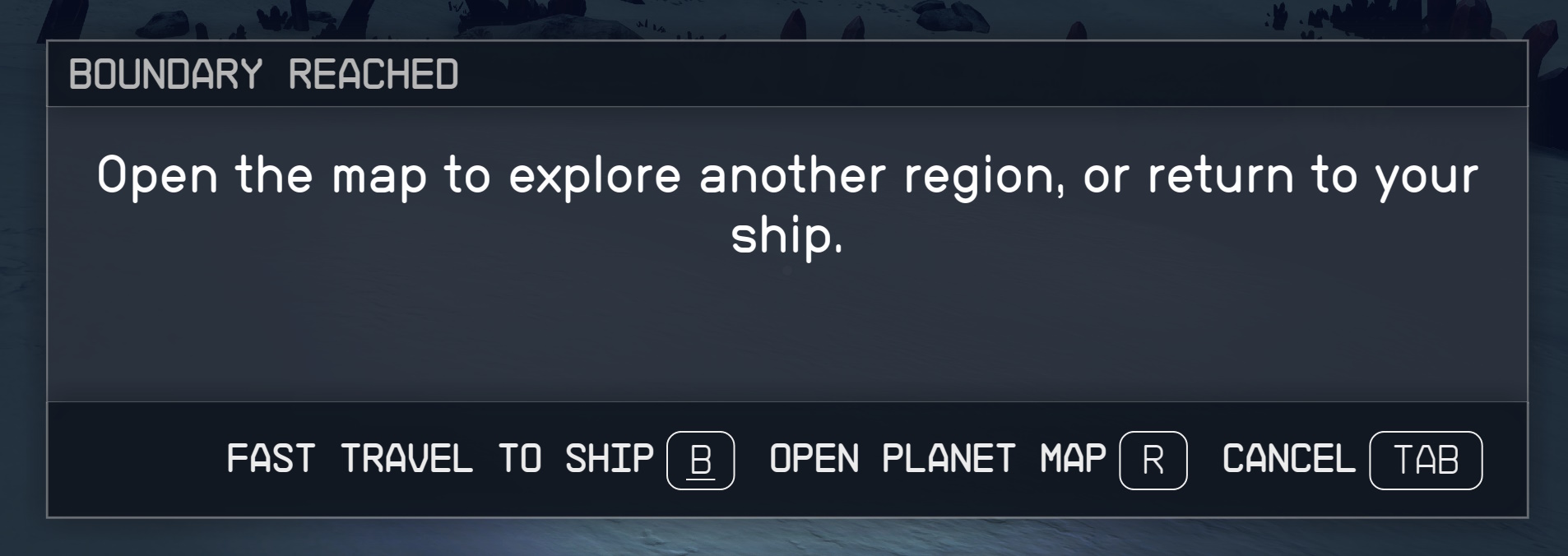
In the roughly twenty hours I’ve spent with Starfield, I’ve encountered absolutely identical locations and buildings on different planets on multiple occasions. Within each “abandoned mine,” enemies spawn in the same place, much of the loot is identical, and the layout of the structure is the same. These so-called “points of interest” on the surface of planets are copied-and-pasted from one to the next, and I’m already bored of that after just a few hours.
Imagine if you visited three identical dungeons in Skyrim, and knew that the fourth one would also have the same enemies in the same places and the same basic loot to grab. You’d start to lose interest pretty quickly, right? Maybe I’ve been particularly unlucky, and maybe there are many more of these randomised locations that I’m yet to encounter. I hope so, but even if that’s the case, the fact that these structures – and everything within – can be repeated at all isn’t exactly a good look.
This was one of my big fears about Starfield from the moment Bethesda began talking of planets being made up of “tiles,” and I’m disappointed to see it come to pass.

One of the early main quest missions is even set at one of these copy-and-paste locations. That actually shocked me when I realised it, because I’d already explored not one but two identical “abandoned mines” on other planets prior to playing this main quest mission. I would have expected at the very least to see locations connected to main quests and faction quests being wholly unique, and again this feels like a disappointment.
One of the things that appealed to me about Starfield was the idea of being able to go “where no man has gone before,” and setting foot on an uncharted world for the first time. But I can’t do that – at least not from what I’ve seen so far. Every single landing zone I’ve touched down at has at least two of these copy-and-paste structures, and no matter how many times I take off again and pick a different spot… they’re always there. Also, every single time I land on a planet, another ship lands a few metres away from mine moments later. There’s no opportunity to feel like a bona fide explorer – the first person to set foot in this strange alien landscape. No matter where you go, someone else has beaten you to it.
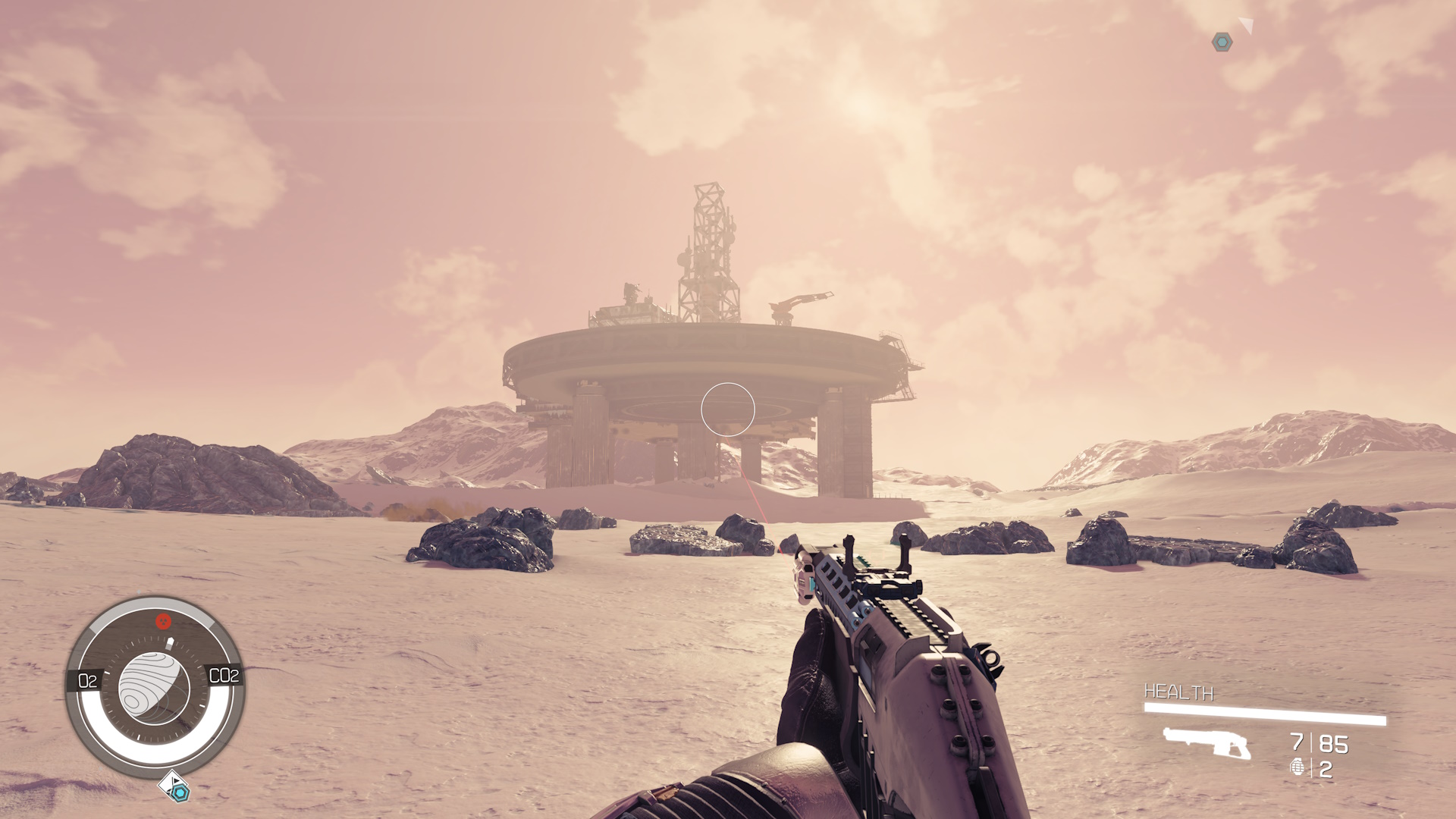
Feeling like I’m at the forefront of this mission of exploration like a Starfleet officer was one of the things I was most keen to experience in Starfield, and the way that the game has handled this hasn’t been great. I literally tried landing at more than fifteen different sites on a single planet, just trying to find one that didn’t have any pre-built structures or spaceship landing sites. But alas.
That’s not to say that there’d be much point in landing at such a site. Starfield is incredibly stingy with its planetary resources, with only a handful of minerals to collect that are scattered across a wide area. With most resources not being worth many credits, any kind of mining or resource-gathering is pretty much out of the question as an in-game career. It’s easier and more efficient to kill random enemies and loot their bases rather than trying to mine or collect minerals and resources.

Much was made at the showcase about gravity, and how different planets will have different levels of gravity. As far as I can see, gravity in Starfield affects one thing: how high you can jump. How fast you can walk or run seems entirely unaffected by gravity, as are shooting and carrying capacity. I haven’t encountered any zero-G sections of gameplay yet, though, so those could spice things up a bit.
Different planets can have different environmental hazards: radiation, heat, and even things like scalding rain or toxic gases. For the most part, the spacesuit and helmet that I’ve had equipped for the bulk of my playthrough thus far seem to be adequate, though my character picked up a couple of environmental injuries early on. I’m not sure if there’s more to this, but I’ve landed on frozen icy planets and even the surface of Venus using the same equipment and I’ve really not noticed a difference.
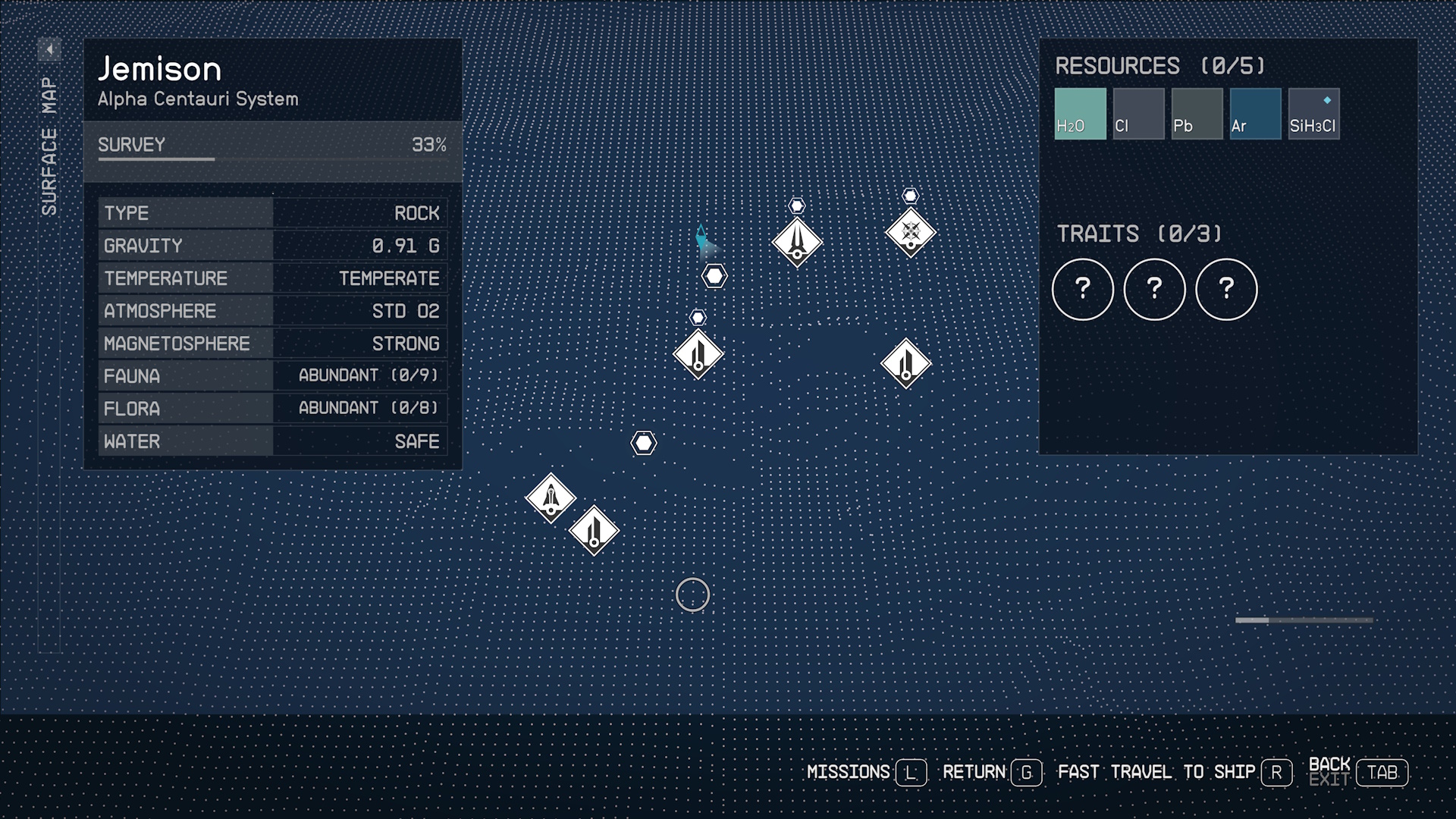
Having a usable map has become an essential feature in any game with large levels – but Starfield bucks this trend. The available map is good enough on the surface of random planets, but utterly useless for navigating cities and settlements.
The map highlights points of interest, and it’s possible to fast travel to any that have been discovered. But god forbid you try to find a particular shop or building in New Atlantis! The map doesn’t have that level of detail for some inexplicable reason.
Spaceflight:

This ought to be nice and short: there isn’t any. There’s functionally no spaceflight in this game whatsoever. Remember being told “if you can see it, you can go there?” Well, you don’t get to actually fly your ship to your destination. You can’t take off from wherever you landed and manually fly to the moon or to the next planet over. No. The only way to travel from one location to the next is to fast-travel from either the map or mission menu.
I fully expected that travelling from one solar system to another would work this way. Who wants to sit around for ages flying through interstellar space, right? But within a single system – and especially to fly from a planet to its moon or from a space station to the planet it’s orbiting – I genuinely expected that I’d be able to take my customised spaceship and actually, y’know… fly it.
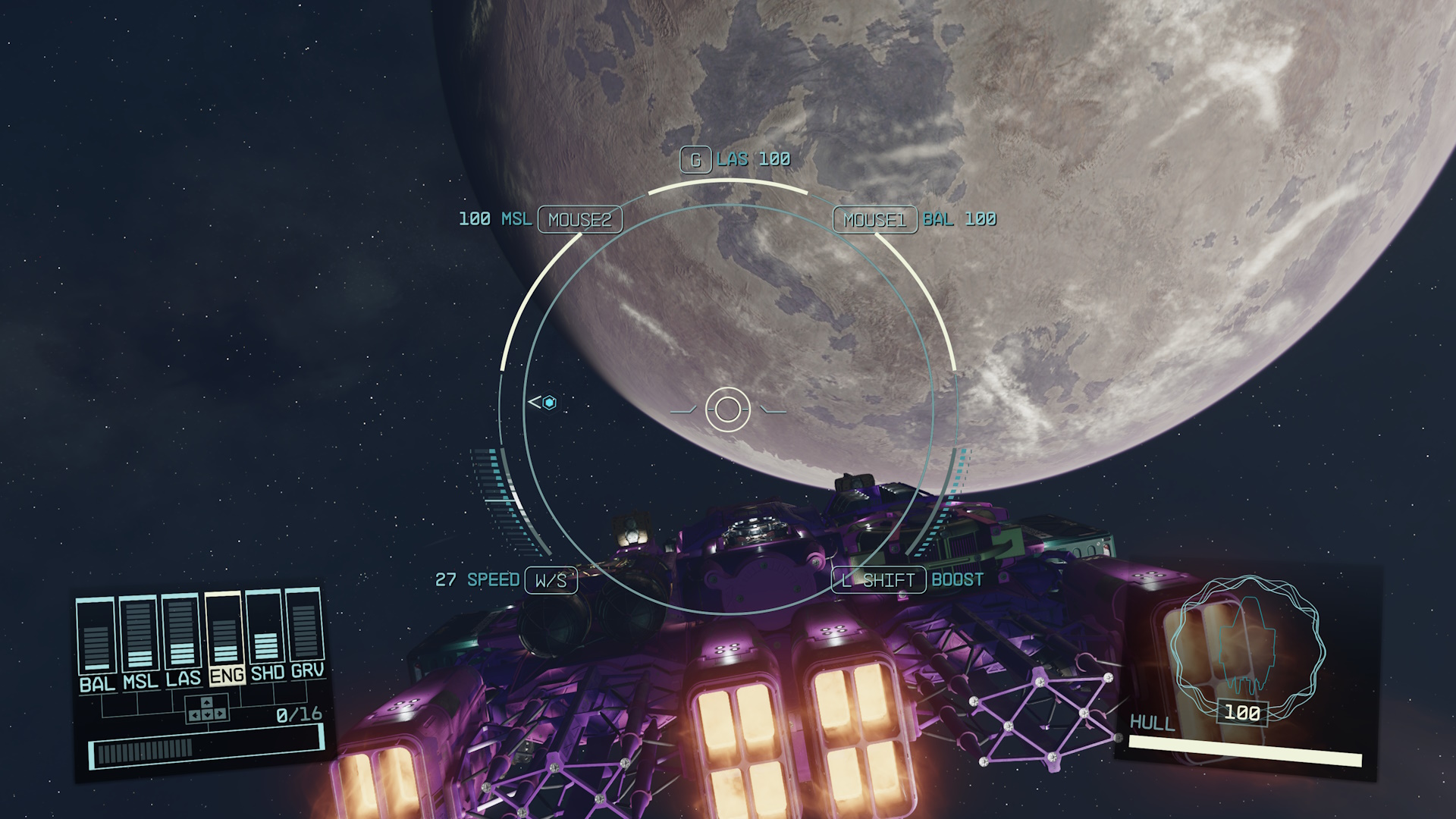
Instead, Starfield drops you and your ship in a little pocket of space, a little bubble. You can fly around within that bubble, talk to any nearby ships, dock with space stations, and the like. But you can’t do anything else, and you’re trapped within that bubble until you open the map menu and select another destination. There’s no option to fly from one planet or moon to a neighbouring one, which is just a disappointment.
What’s the point of building a custom spaceship if you can’t actually get to pilot it for any significant length of time? Sure, there are some combat encounters in space that are tense, and it’s a bit of fun the first few times you get scanned for contraband, hail a friendly ship, or dock with someone. But there’s not a lot of longevity in most of those activities, and the decision to basically offer no actual spaceflight in a space game… it’s an odd one to say the least!
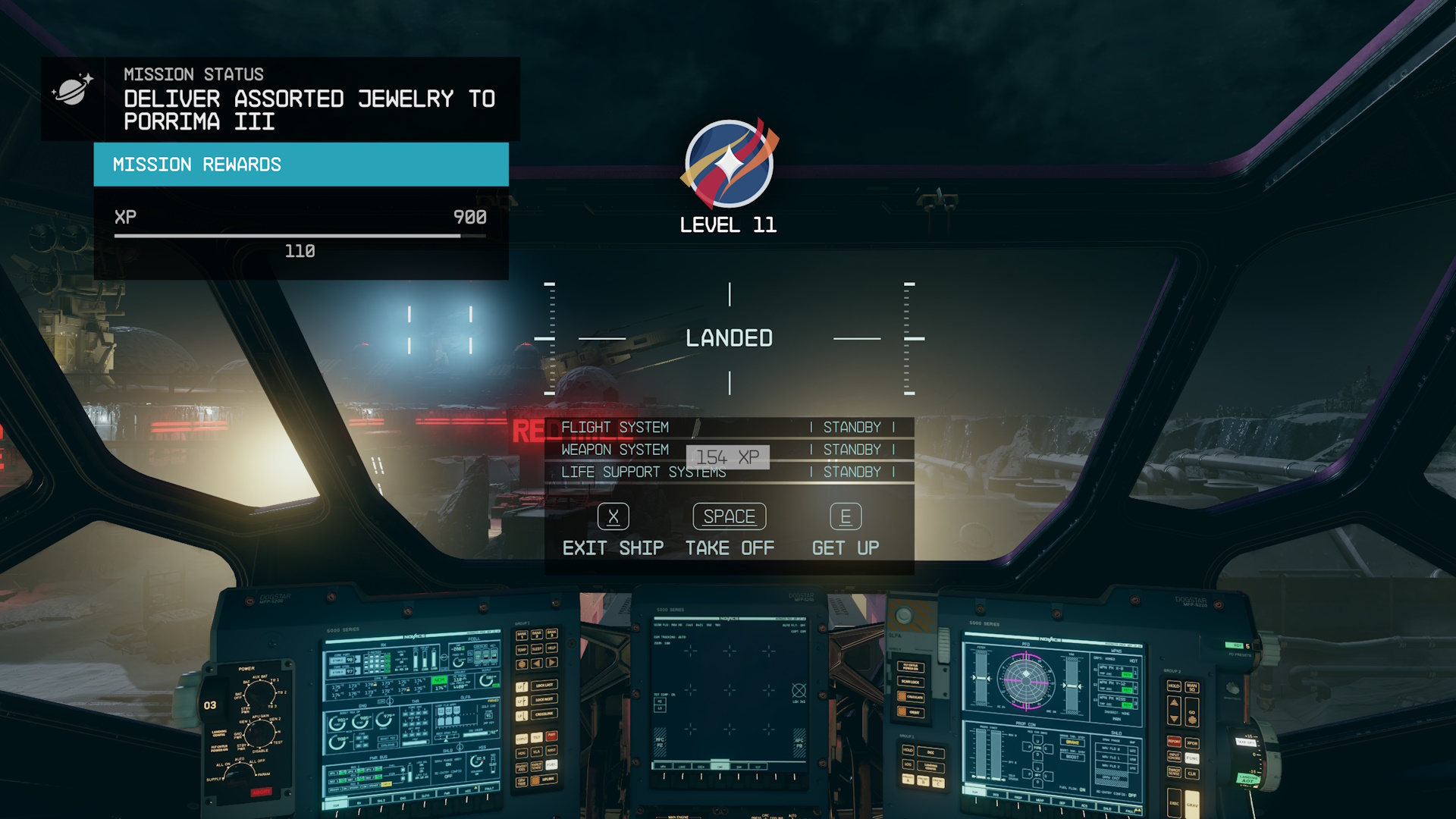
Some missions operate the same way. After choosing an assignment from a “mission board” located near a spaceport, you’ll be tasked with some relatively mundane job in exchange for credits. One that I chose involved delivering a shipment of jewellery from one planet to another. But to call these “missions” is massively overstating it!
After selecting the task I wanted from the mission board, the quest was available in the menu. But I didn’t have to go anywhere to collect the cargo; it magically appeared on my ship instantaneously. All I had to do was board my ship, select the destination planet from the map screen, and away I went. I mistakenly assumed that I’d have to talk to someone or at the very least interact with a screen in order to transfer the cargo and complete the assignment – but no! The mission was automatically marked as complete the very second my ship touched down. I didn’t even need to get out of my seat, and the entire thing took less than a minute from choosing the task to marking it as complete and receiving my reward. Hardly an interactive experience – and while such tasks may be useful for making a bunch of credits in short order, it wasn’t fun and it wasn’t immersive.
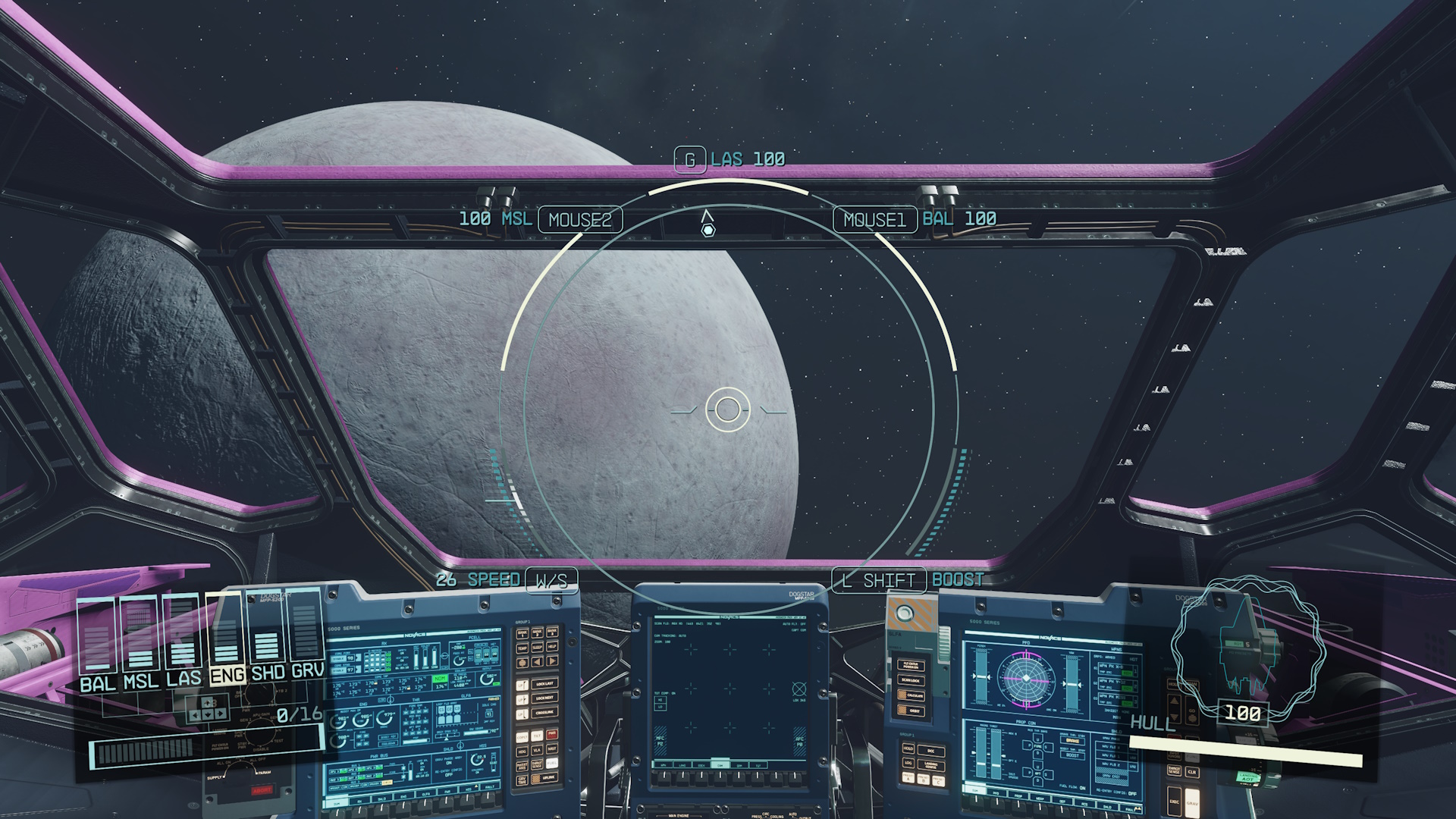
Maybe this is more of a personal taste thing, but I really dislike the way Starfield presents its heads-up display while piloting a spaceship. I found the HUD to be incredibly cumbersome, especially in first-person mode, and it got in the way of the immersion of being a space captain or space pilot. Displaying these little transparent boxes on top of in-game computer screens and monitors really detracts from the piloting experience.
Even in third-person mode, the HUD is still obtrusive and takes up a lot of real estate on the screen. I’d have loved to see Starfield make actual use of those screens and displays in the cockpit, as that would make for a much more engaging and interactive experience. Offering players a choice, at least, with a simplified HUD or smaller HUD as options would have been nice, too.
Graphics:

If Starfield had been released on the PlayStation 4 and Xbox One, I’d have said it looked great. And some of its backdrops and vistas look pretty. Seeing a planet from space or seeing a landscape stretching off into the distance are genuinely great moments, and they’re rendered well. But when you start looking at things up close, a lot of Starfield’s next-gen trappings fall away.
The main area of complaint here is the characters’ faces. Eyes are dead and faces flip-flop from being totally blank and expressionless to having almost comically exaggerated movements, then back again. Every character, regardless of race or age, looks to be about twenty-five years old, with smooth skin and perfect teeth. Practically all characters are the same height, and most are the same build, too.
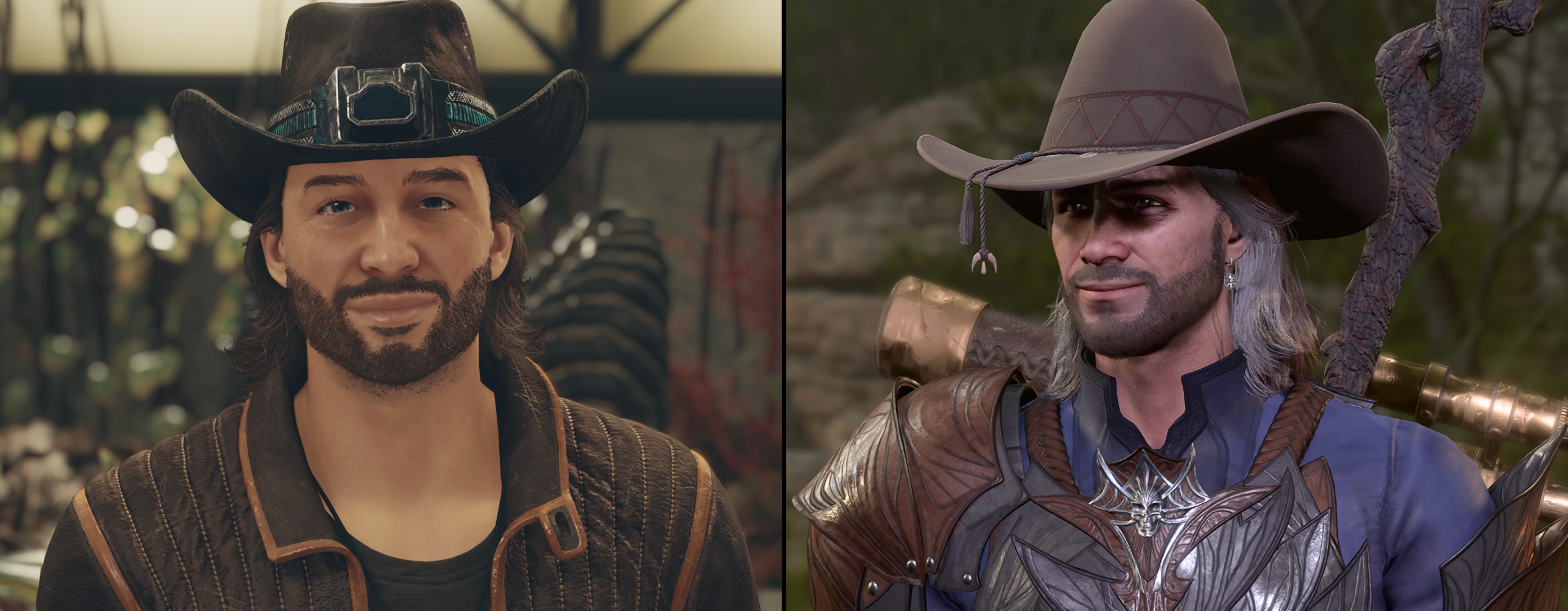
The image above is one I believe offers a fair comparison. On the left we have the character of Sam Coe from Starfield, and on the right, Gale from Baldur’s Gate 3 – wearing a similar hat to make comparing them easier and fairer! I picked these two characters because they have a similar look, and are both major NPCs and companion characters in their respective games. You can tell at a glance which looks better and more lifelike, and that’s without even seeing them moving or being animated. In short, Bethesda has fallen a long way behind when it comes to faces – and this comparison proves it.
“But graphics don’t matter!” goes the frequently-heard retort. And I agree to an extent – many games deliberately employ art direction that isn’t intended to be realistic, going down a “retro” route of pixels and polygons or choosing a cartoony aesthetic, just to give two examples. But Starfield is trying to be realistic – and at least in terms of faces and character models, it misses the mark by a country mile. Games in the same role-playing space by other developers look so much better than Starfield, which is, at best, a polished and shinier version of Fallout 4.
Story:

Thus far, I don’t feel particularly engaged with either Starfield’s main story or the world that the game is trying to build. In true Bethesda style, the player character is some kind of “chosen one,” able to see visions when interacting with mysterious artefacts. But the game’s opening act felt pretty rushed, with my nameless miner picking up an artefact and then being whisked away by Constellation mere minutes later. I get that Bethesda needs to make this section of the game as curtailed as possible so it doesn’t drag too much on repeat playthroughs, but I couldn’t shake the feeling that there wasn’t much explanation provided for why my character was essentially given a free spaceship and shoved off into the cosmos.
The artefacts themselves are pretty bland to look at, and the visions, while certainly mysterious, don’t really offer much else. I don’t feel compelled to keep pushing to figure out what the artefacts are or where they’ve come from, and while a decent ending or a good explanation could certainly reframe this aspect of the game’s story and make it more interesting, that hasn’t happened for me yet.
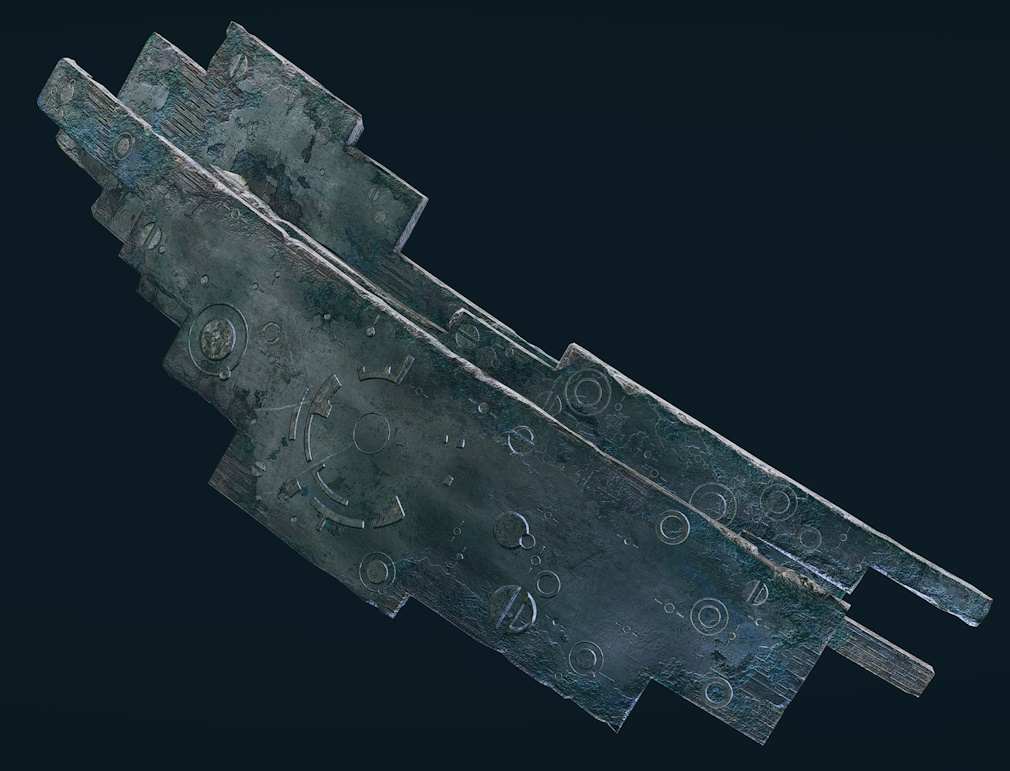
In terms of storytelling, the side-missions I’ve played so far didn’t feel especially interactive or player-led. On one occasion I stumbled upon a farmstead that was under attack by spacers, and as the mission unfolded I had to recruit other local families to join in the defence of their system from these raiders. But at every stage, the mission felt like it was being organised and led by the very people I was supposedly helping. They discovered the locations I needed to attack, they planned the mission, and it was at their direction that I did, well, everything. I didn’t even have the basic choice to try to do the mission through stealth; a full-frontal attack was literally the only option.
What this meant, when the dust settled and the questline was complete, is that I didn’t really feel like I’d done anything different. Attacking this group of spacers, killing them, and looting their base scarcely felt any different from attacking, killing, and looting random bases on other worlds, and I felt that my character really didn’t engage much with the quest-giver beyond listening to his plan and following orders. As the questline wrapped up and the quest-giver showered my character with praise for defeating the spacers… the whole thing just felt rather hollow.
Scale:
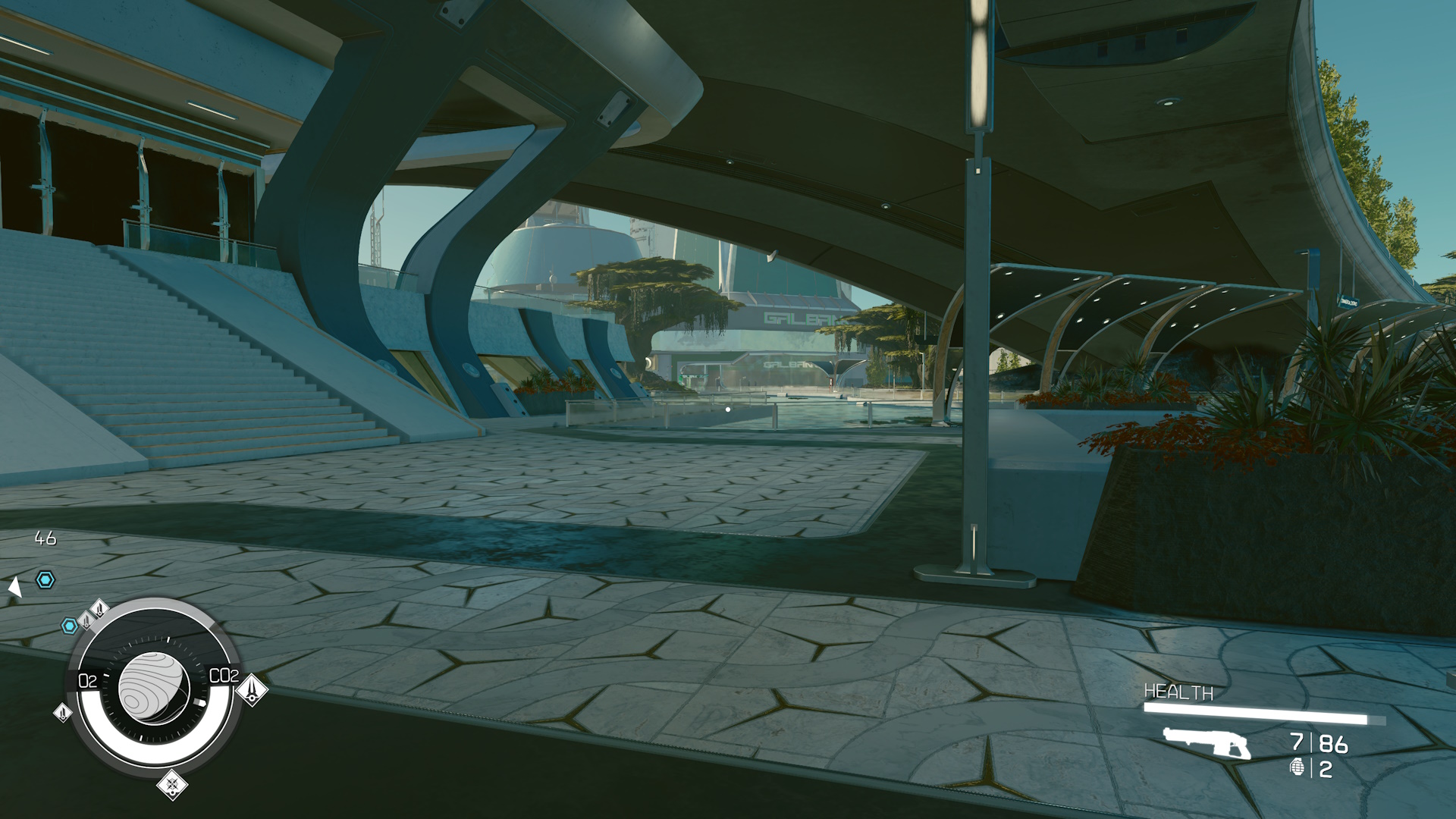
Before Starfield launched, I wrote a piece here on the website about my concerns surrounding the sense of scale that a game like this needs to have. I zeroed in on two factors: the amount of content relative to the size of the map, and the way other games manage to convey the feeling that players are taking part in a story that only scratches the surface of a much larger world, one that exists beyond the confines of the playable area.
Parts of Starfield feel… small. Exploring New Atlantis – supposedly the biggest city that Bethesda has ever created – feels akin to walking around a small town, not the capital city of a futuristic humanity. There’s no sense of scale, no ambience, and the city doesn’t feel believable. Parts of it are literally deserted, and the handful of people who are milling around are more often than not nameless “citizens” with nothing to say.
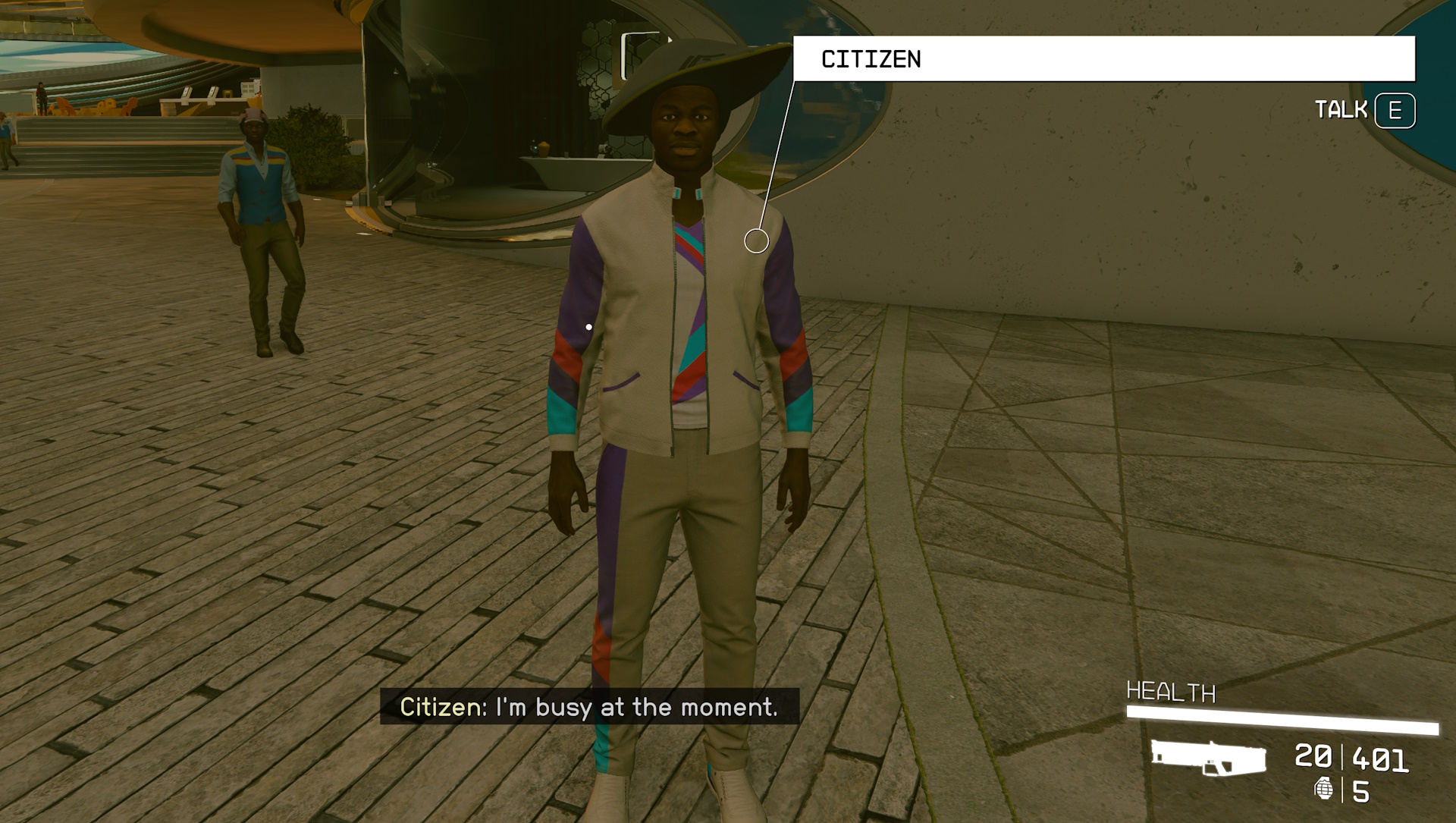
The aforementioned lack of spaceflight also cuts into this sense of scale. Because Starfield allows you to hop from one planet to the next by opening a menu, there’s no feeling that you’ve actually travelled, or that the destination you’ve reached is far away from the spaceport that you departed from. What should be a vast, open galaxy feels small as a result.
Doubling-down on this feeling are the copy-and-paste locations present on planet surfaces outside of the main settlements. I truly can’t believe how many repeat locations I’ve encountered in such a short span of time, and this is again something that really drags Starfield down.
Customisation Part 1:
Character Creation:
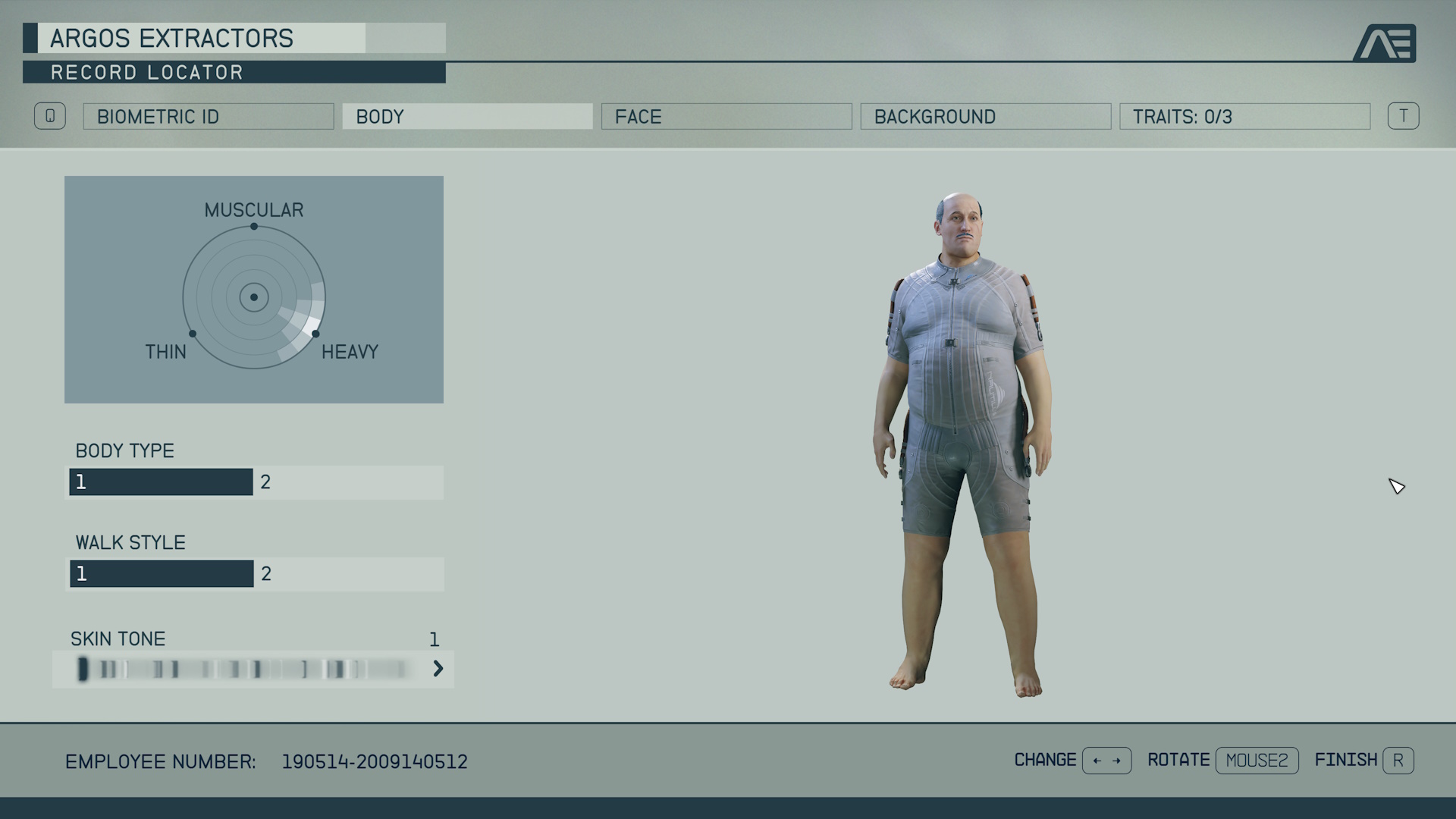
The character creator in Starfield has left me with mixed feelings. Firstly, there seems to be a pretty big difference between the way your character looks when initially creating them and how they actually appear during gameplay. Maybe this is due to lighting or other effects, but I felt my character looked noticeably worse after exiting the character creator. And having spent ages working on them… that didn’t feel great.
There are some great options within the character creator to represent different body types – but this isn’t as extensive as it could be. You can choose whether to be thin, muscular, or fat, for example, or any combination of those three things, but not your character’s height. There are plenty of options for various skin types, including things like vitiligo, freckles, and wrinkles, but very few hair and facial hair options. When it comes to reflecting diverse hair types… that’s poor.
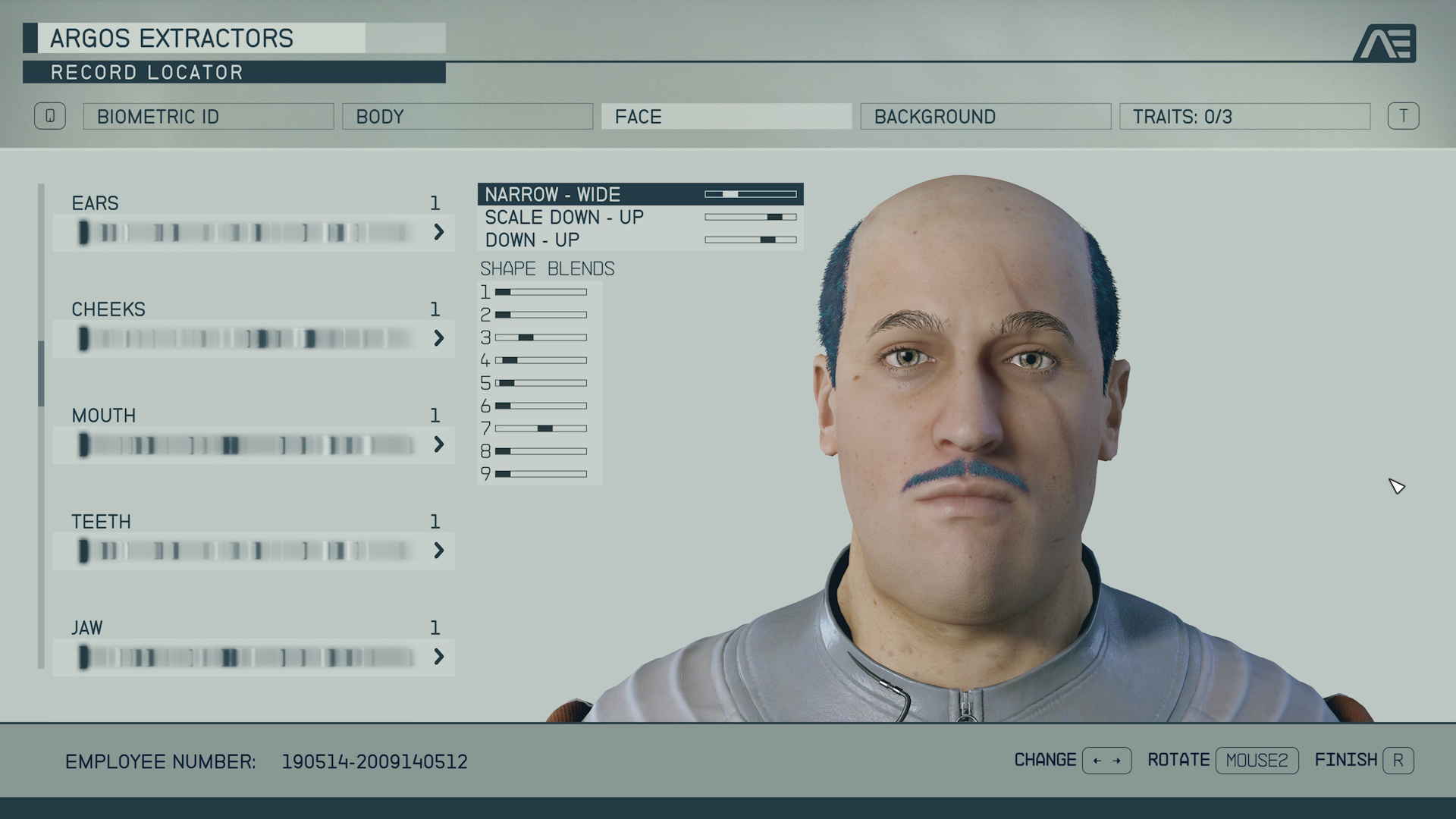
Eye colour is likewise very limited. Baldur’s Gate 3, which was released last month, and even 2020’s Cyberpunk 2077 offer far richer and more detailed character creators, and I think it’s a shame that Bethesda hasn’t really made much progress here since Fallout 4. And speaking of Fallout 4: several of the hairstyles seem to be lifted directly from that game, retaining their ’50s-inspired look that doesn’t particularly suit Starfield’s retro-sci-fi future.
As a quick comparison, Cyberpunk 2077 has 35 hair colours and more than 50 hairstyles to Starfield’s 23 hair colours and 40 hairstyles – an absolutely massive difference considering it’s almost three years old and was released on last-generation hardware. And Baldur’s Gate 3 has well over 100 colours and more than 85 styles to choose from, showing what a modern game is really capable of in that department.

What’s the point in Starfield offering 100 ways to reshape your nose or cheekbones – things that are barely perceptible in-game – while only offering a handful of eye colours and hairstyles? These things go a long way to making a character feel personalised and unique, and when there are so few options, within a matter of minutes you’re likely to be running into NPCs who share some part of your character’s appearance or who look alike. Given the aforementioned issues with the way the game renders faces, the fact that many NPCs look similar to one another is verging on immersion-breaking.
The Starfield showcase really played up the various backgrounds and traits that are available during character creation. And to the game’s credit, these traits and backgrounds are varied and interesting. However, I would say that in my twenty hours with the game, the only place where my character’s background has even been mentioned so far was in the intro/tutorial sequence right at the beginning. Now, there are likely to be more opportunities for random lines of dialogue to appear, but so far I haven’t seen very many.

I picked the “Raised Enlightened” trait, one of three potential religious affiliations. Partly I did so because in-game text promised access to a chest in New Atlantis, of which there seems to be one for each religion, and I figured that the chest may contain items that could prove useful in the early game. This chest was a complete nothing-burger, offering a handful of health packs and four “books” – which are a couple of pages long at most.
Another trait I chose was “UC Native,” meaning that my character was born in the United Colonies, one of two major factions in the game. While this has some bonuses when completing missions, it doesn’t really come with a lot of perks. For instance, I was told early on that I’m not actually a “citizen” of the United Colonies – presumably so I can have access to the same questline to become a citizen as players who didn’t choose this option. But then… what was the point of choosing this trait? It doesn’t seem to have affected my character in a meaningful way.
Customisation Part 2:
Spaceships:
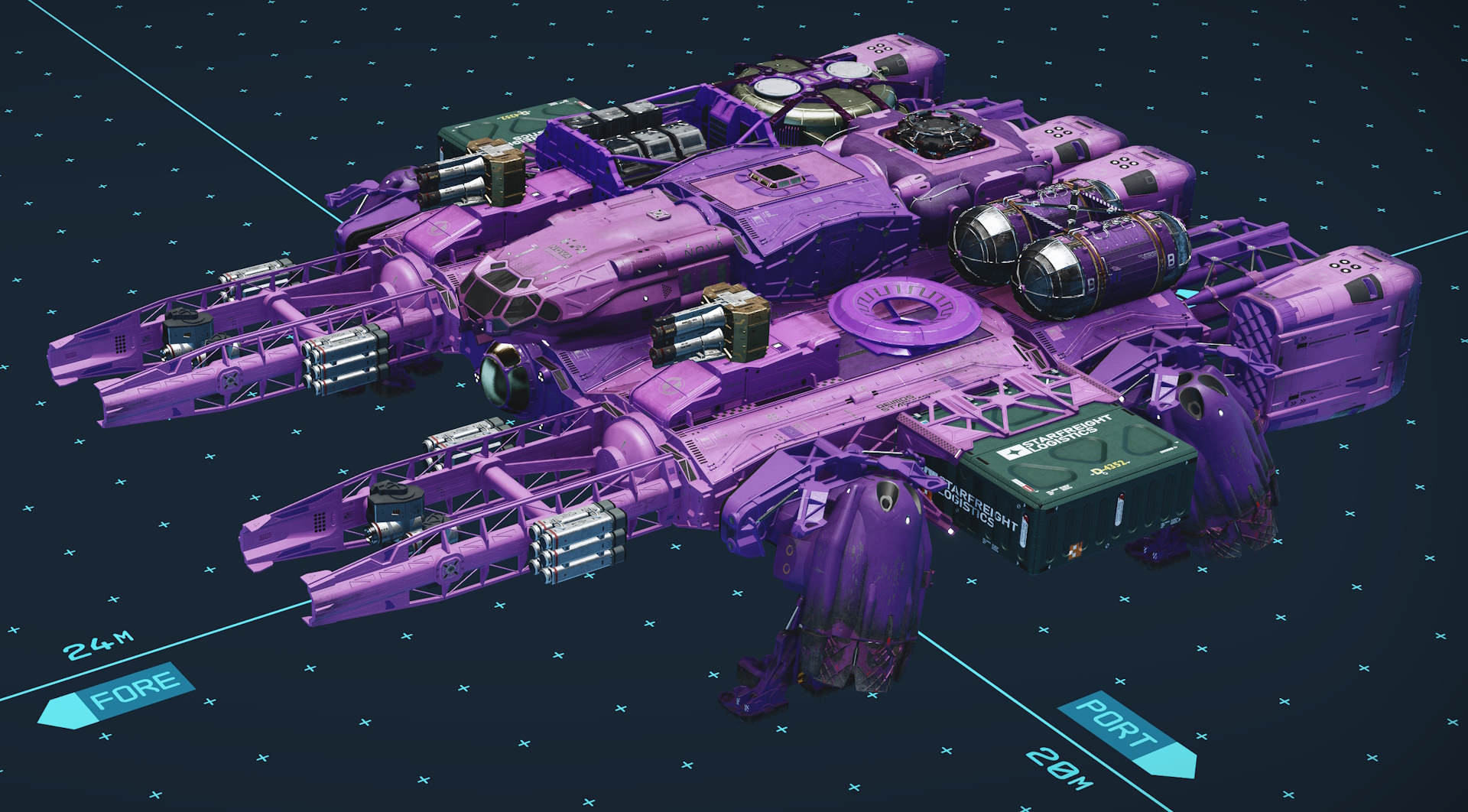
Spaceship building was one of the parts of Starfield that I was most excited about. I’ve loved the idea of creating my very own spaceship ever since I played the likes of Star Trek: Starship Creator in the late ’90s, and being able to not only build my own ship, but pilot it, take it into combat, and get out of my chair and freely walk around the interior are all aspects that held huge appeal.
The ship creator is fun – but it requires a significant investment of credits to get started with, and is a bit more finicky than I’d hoped to see. Some components are incompatible with one another, there are limitations on where some parts can be placed and what they can connect to, and the way weapons have to be manually “assigned” is cumbersome and annoying.

That being said, building my own ship is about as much fun as I realistically expected to have. It isn’t perfect, and in an ideal world there’s a lot I’d add (and a few things I’d remove) to make the experience even more enjoyable. But there are plenty of colour options, and the fact that ships can be assembled in a range of configurations is great. I’d like to see more components and modules – but I don’t think I’ve seen or unlocked all that the game has to offer, so it’s conceivable that I’ll come across more options as I progress.
As I said a few times before Starfield launched, if spaceship interiors could be customised, Bethesda would have said so. While I was still crossing my fingers, this didn’t feel like a realistic prospect as the game edged closer to launch. Even though I’d resigned myself to this reality… it’s still disappointing, especially considering that Starfield does allow for interior designing and decorating in outposts and houses. Would it have really been much more complicated to add this already-present feature to spaceships, too?
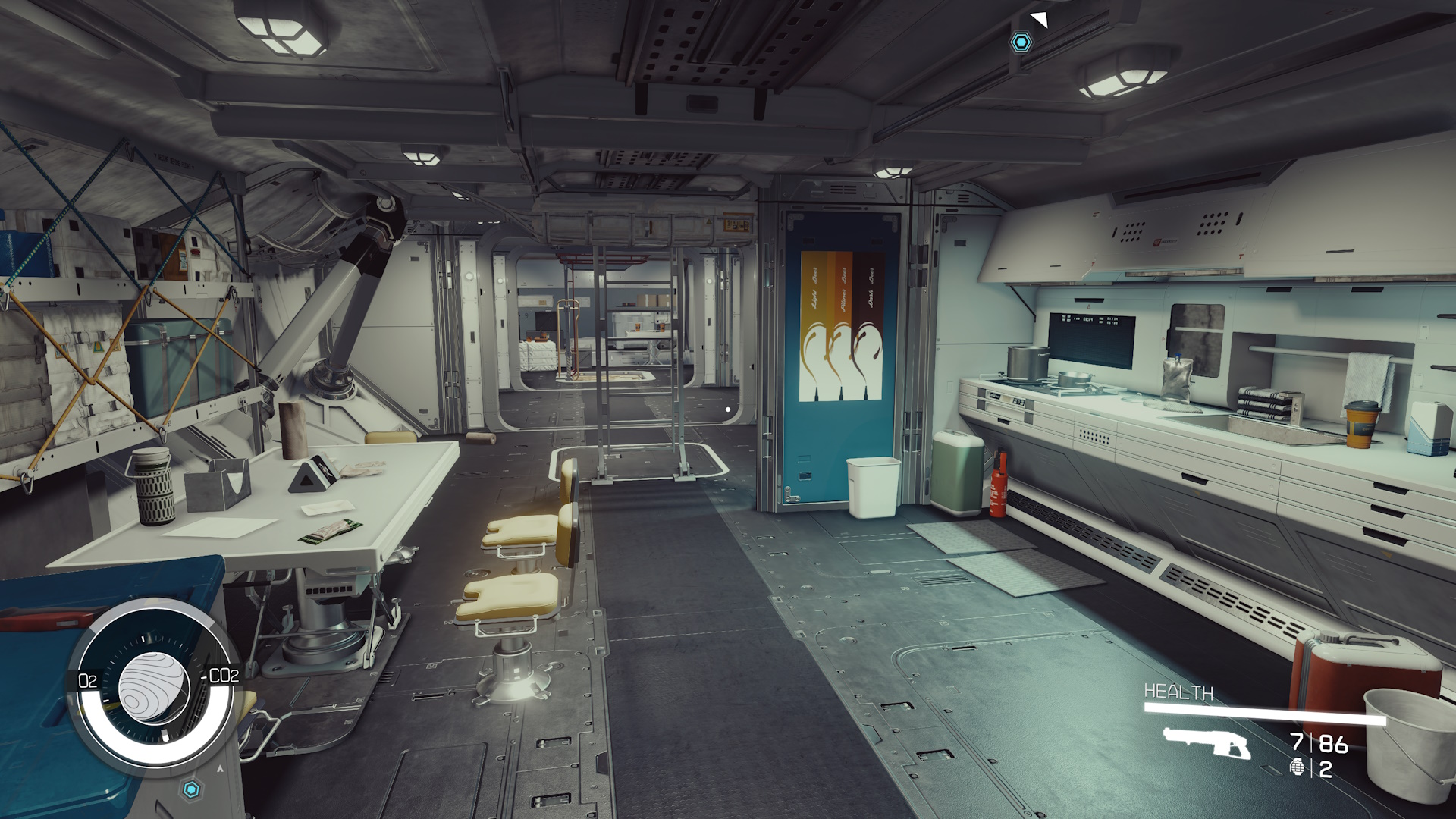
My spaceship doesn’t feel like “mine.” There’s a half-eaten sandwich on a table that my character didn’t bite. There are notes on the whiteboard in my “captain’s cabin” that I didn’t write (and have no idea what they mean). Although my spaceship is a fetching shade of pink on the outside, the walls inside are a generic white colour. I can’t even repaint hatches and doors, nor choose the colour of the furniture.
While it is possible to drop items aboard the ship and have them remain where they fall, this particular mechanic has literally not been improved since Morrowind. It’s not possible to precisely position items, meaning I can’t even set the table for dinner with a knife and fork. For me, these things are all part of the immersion – and when they aren’t present, my ship just feels bland and generic, and not personal at all.

A spaceship can be renamed at will, which is great, but names are limited to a scant fourteen characters. “Enterprise-D” fits, but “Millennium Falcon” doesn’t. I’ve no idea why Bethesda has been so stingy with the character limit here, as it cuts off a good deal of ship naming possibilities.
And while we’re on the subject of names: remember Todd Howard telling you that Vasco, the robot companion, could say your name and the name of your ship? Well, that hasn’t happened for me yet, despite taking Vasco all over the galaxy and having him accompany me on a number of missions. Not sure if there’s some hidden requirement to unlock this, but if there is, I haven’t found it yet. I didn’t give my character some kind of horribly obscure name, and I was looking forward to hearing this robotic voice say it; it’s another addition to the immersion. Considering what’s possible with text-to-speech nowadays, there’s no reason why Vasco should be limited to a handful of pre-recorded names.
Customisation Part 3:
Outfits and Loot:

I miss the days when you could mix and match outfits. Clothing in Starfield comes by way of whole costumes, with no option to change shoes, pants, shirts, and the like. There are hats that can be equipped individually, but that’s it. I find this to not only be disappointing, as it seriously cuts into the customisation and role-playing aspect of the game, but also a pretty big regressive step.
As far back as Morrowind, Bethesda games let you choose individual pieces of clothing. Shoes, trousers, tops, and even individual pieces of armour were all separate and could be mixed and matched at will. Even though that game is more than twenty years old, it seems like it had more customisation options when it comes to apparel.
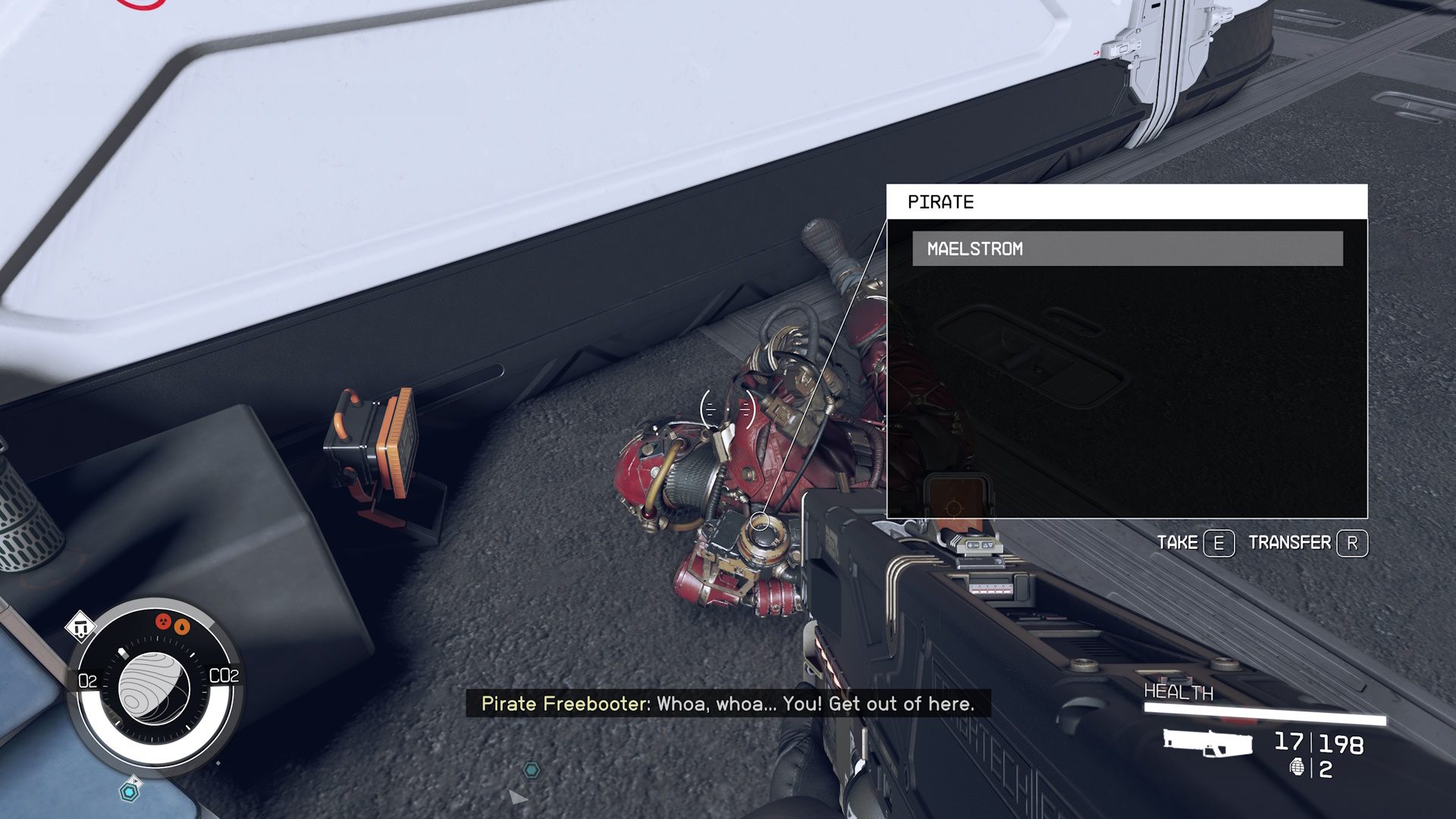
In addition, Starfield doesn’t appear to have a huge array of clothing options to choose from. I think I’ve seen a couple of dozen different outfits, maybe, across my playthrough so far – including from several different vendors. And while looting outposts and enemies, I keep picking up the same ones over and over again. At one point I literally had 20 of the same spacesuit.
And this is true of other items, too. Even if you’re lucky enough to come across a building or base that you haven’t seen before – i.e. one that may not be a total copy-and-paste job – the items in it are remarkably samey. You’ll soon be able to identify which items are valuable and which to leave behind… because there really aren’t that many different ones.

Looting a base can be a frustrating experience at points. Some items that look like they should be collectable aren’t, they’re just part of the scenery and can’t be picked up or interacted with in any way. And the items that can be collected soon feel repetitive. Sure, these items are, to some extent, a means to an end. You’re looting the base or scavenging in order to sell the items for credits to spend on things like ship upgrades or building a base.
But it begins to harm the sense of immersion to constantly be picking up the same handful of items over and over again at different places across the galaxy.
Combat:
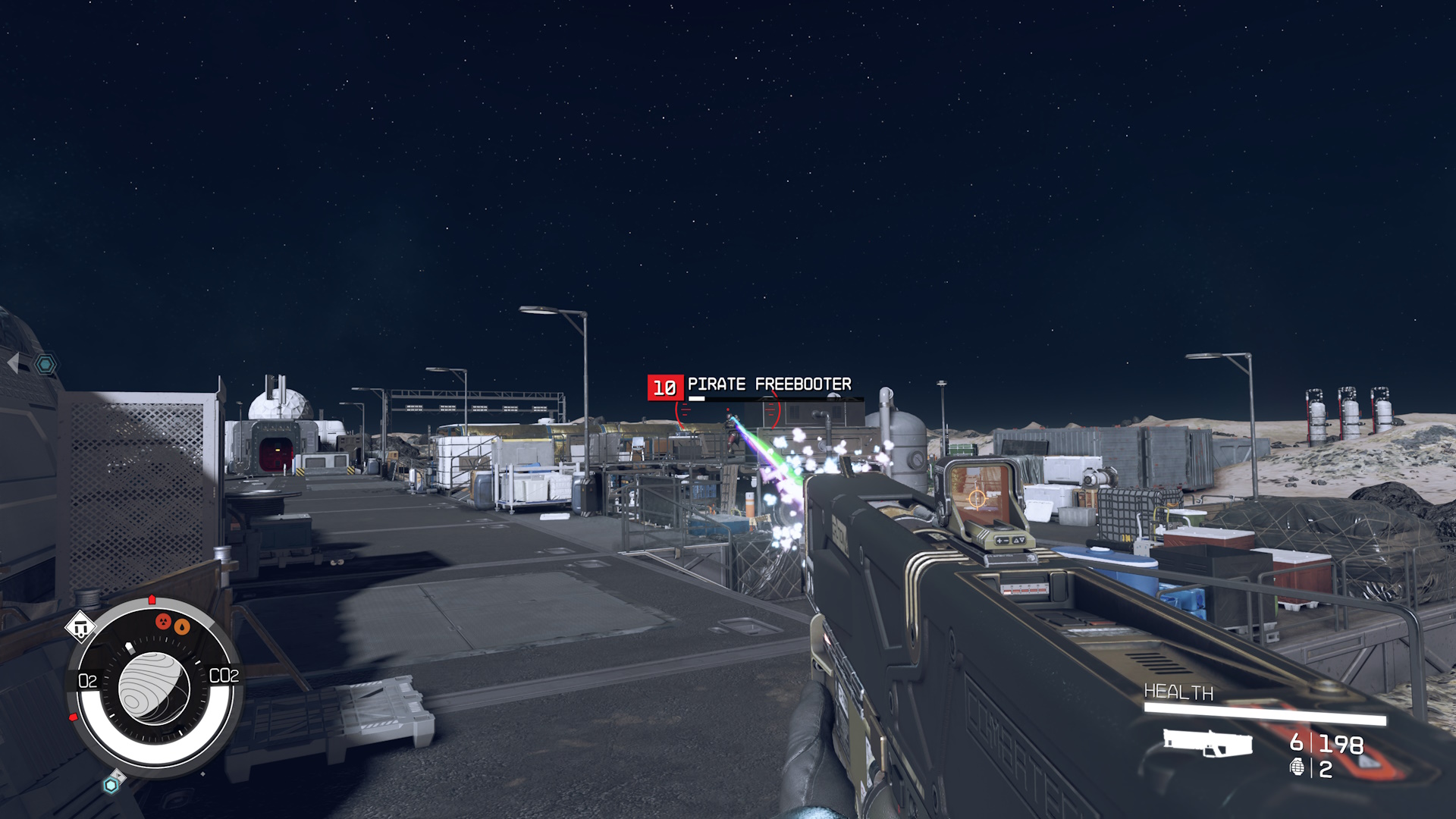
Combat in Starfield is solid. First-person combat with both guns and melee weapons is probably on par with similar titles in the action-RPG space like Cyberpunk 2077 – though with admittedly fewer options and less variety. But for Bethesda, this is a massive improvement! We’re not reaching the levels of a dedicated FPS like Doom Eternal, and enemies can feel a bit over-armoured and bullet-spongey. But considering how mediocre gunplay was in Fallout 76 (or Bethesda’s other Fallout games when you take VATS out of the equation) I must say I’m impressed.
I had some genuinely fun and tense moments fighting pirates and spacers, and gunplay felt fast-paced and exciting. Different weapon types behave differently and can apply different effects to a target, and there are some “rare” or “legendary” weapons that I’ve come across that have additional bonuses. I think crafting and modifying weapons is also an option here. The only drawback, at least in the first few hours of the game, is that there isn’t all that much variety. I might’ve come across a dozen different guns in total – but when you break that down into lasers, rifles, pistols, and shotguns… well, that’s literally three of each. I hope there’s more that I haven’t discovered yet.
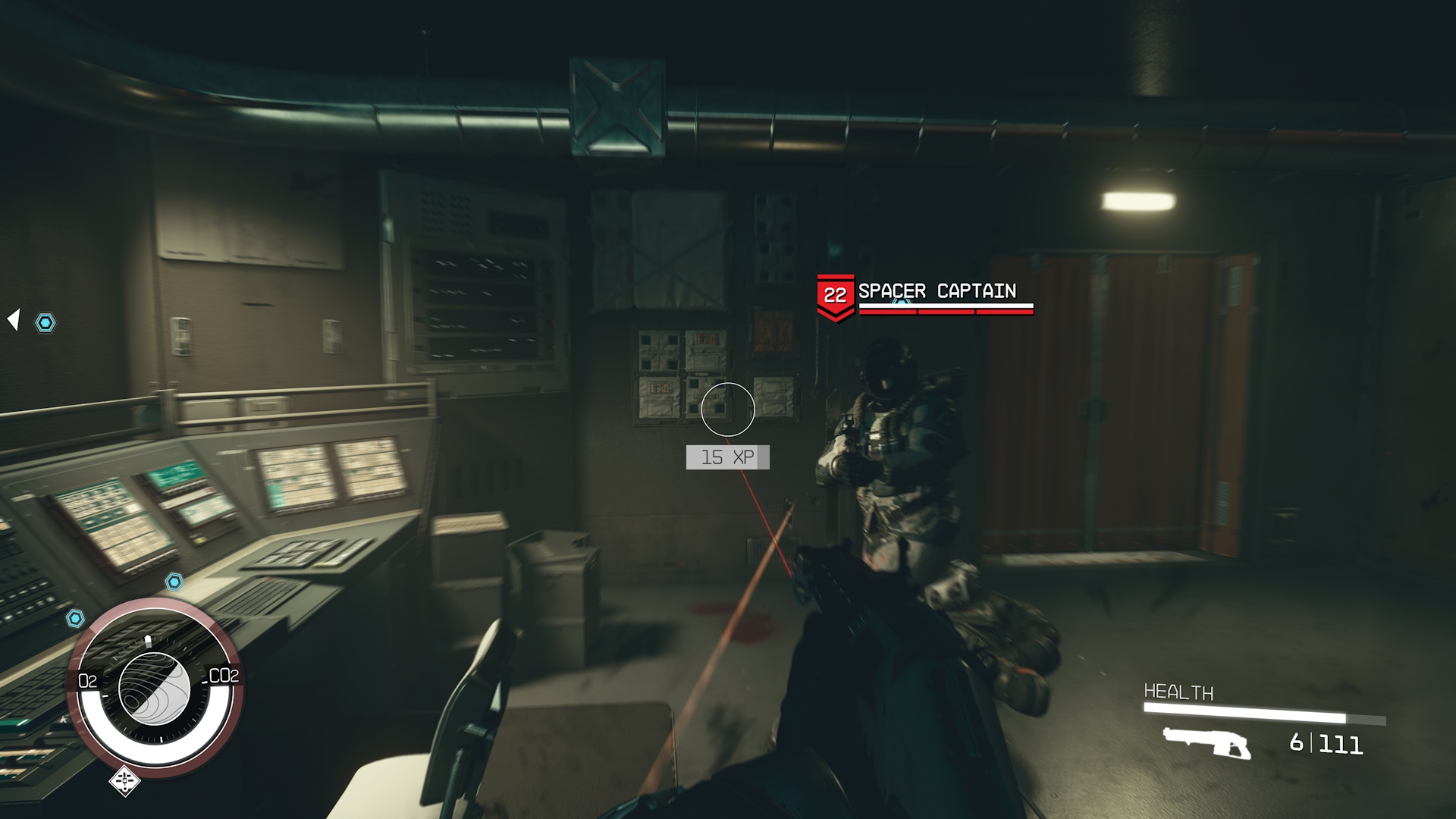
Space combat is likewise fun, though perhaps I’d call it the lesser of Starfield’s two ways to fight. Where gunplay on the ground felt a bit more strategic, with a need to take cover, aim, and generally plan how to win a fight, space battles seem to mostly consist of mashing the buttons over and over again. There is targetted aiming, which is how you can try to disable an enemy ship for boarding, but this is inexplicably locked behind a skill point and can’t be accessed right off the bat.
That being said, I’ve had some exciting space combat encounters in my time with Starfield so far. On one occasion I was overwhelmed by a force of spacers and had to grav-jump to safety, and waiting for my grav-drive to power up with my shields down and enemy ships raining a hail of missiles down on me was a genuinely tense and thrilling moment.
Polish and Bugs:
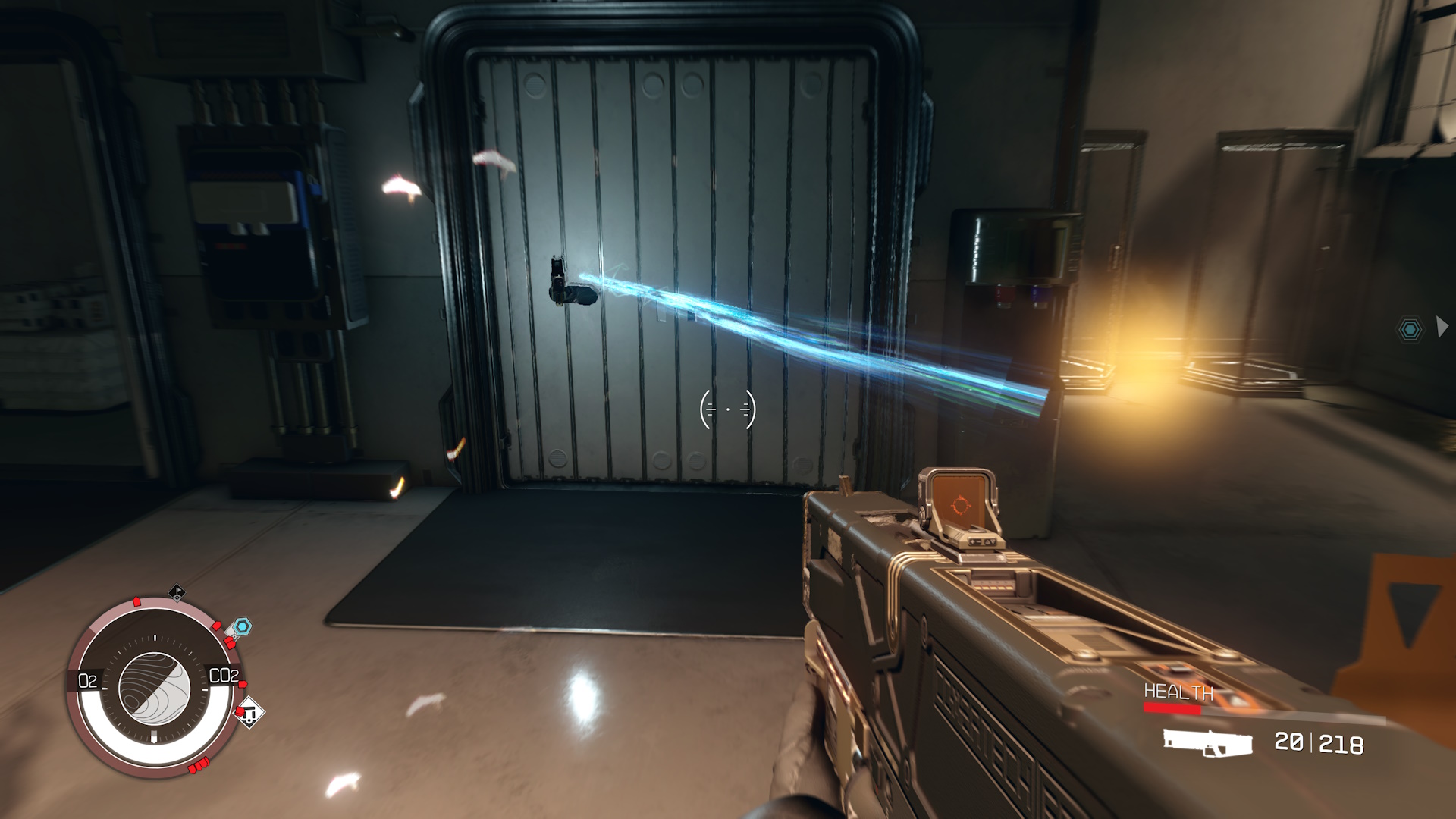
Before the game was released, there was a particularly audacious claim by Matt Booty, head of Xbox Game Studios, that Starfield would have “the fewest bugs of any Bethesda game ever shipped,” and I said at the time that he would absolutely be held to account for that! I haven’t encountered any game-breaking bugs, unfinishable missions, or hard crashes while playing Starfield, and unlike many PC games over the last couple of years, the game seems to run well out of the gate. The frame-rate feels decent, there hasn’t been any stuttering, screen-tearing, or frame-drops, and overall the performance feels solid.
I have noticed that my GPU – an Nvidia RTX 3070 Ti – seems to run hotter than usual and with its fans spinning faster than usual while playing Starfield, but I wouldn’t call that a cause for concern at this stage – and it’s something that could be patched or perhaps modded somewhere down the line to improve things.
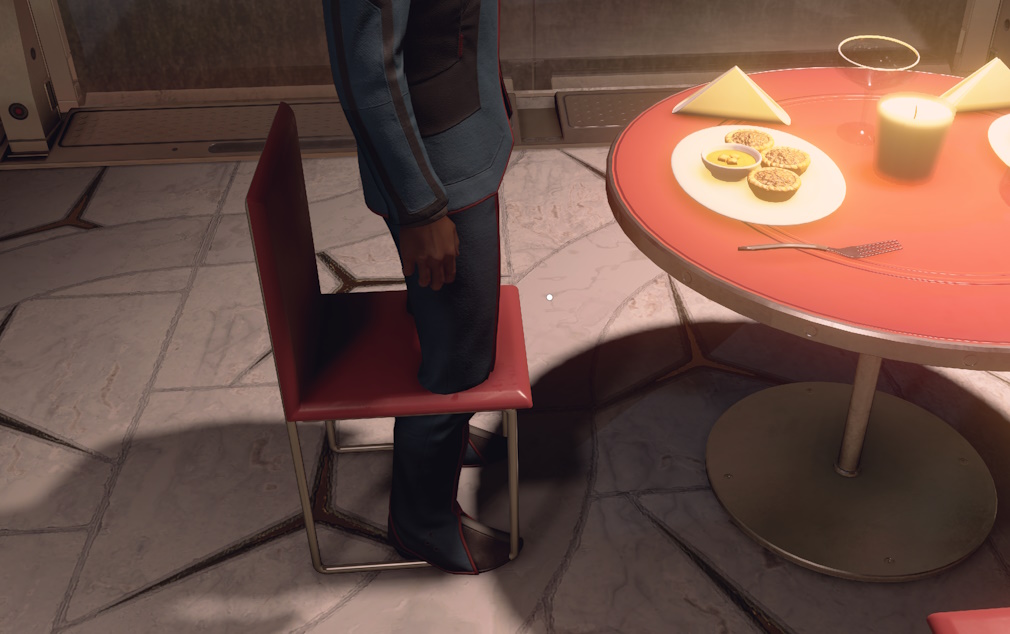
However, some bugs have slipped through the cracks, despite Starfield’s long and exhaustive QA process. And many of these bugs feel like your typical Bethesda/Creation Engine fare: characters clipping through walls or doors, being able to shoot through doors, levitating, or making random movements. At one point a character I was in conversation with was facing the wrong way. Characters and items will occasionally “slide” as if on a polished or icy surface.
None of the bugs I encountered stopped me from completing a quest – though a handful of times an item or piece of loot would float away, leaving me unable to retrieve it. The bugs feel akin to those found in other Bethesda titles at launch, which some people claim to find endearing. I don’t – and given the promises attached to Starfield on the bug front, it’s disappointing to have seen so many bugs and glitches within just a few hours of playtime.
Conclusion:

Starfield isn’t as much fun as I’d hoped it would be. It’s a game that brings together systems and mechanics that have been done before – and done better – in other titles, some of which are several years old. What it does offer is all of those things in one package, in the framework of a Bethesda RPG. If Bethesda and Xbox had done a better job of setting expectations, and had been more willing to say “no” and shut down wild speculation when it started to get out of hand, perhaps some of that disappointment could have been avoided.
That being said, Starfield isn’t a bad game by any means. I fully intend to spend more time with it, and it’s not inconceivable that my opinion will shift if the story picks up and I begin to find more items to loot and things to do. I just don’t feel especially engaged with Starfield right now, and the story hasn’t grabbed me in the way I’d have hoped. If it had, perhaps things like limited landing zones or spaceflight consisting more of fast travel menus than anything else wouldn’t feel like such a let-down.
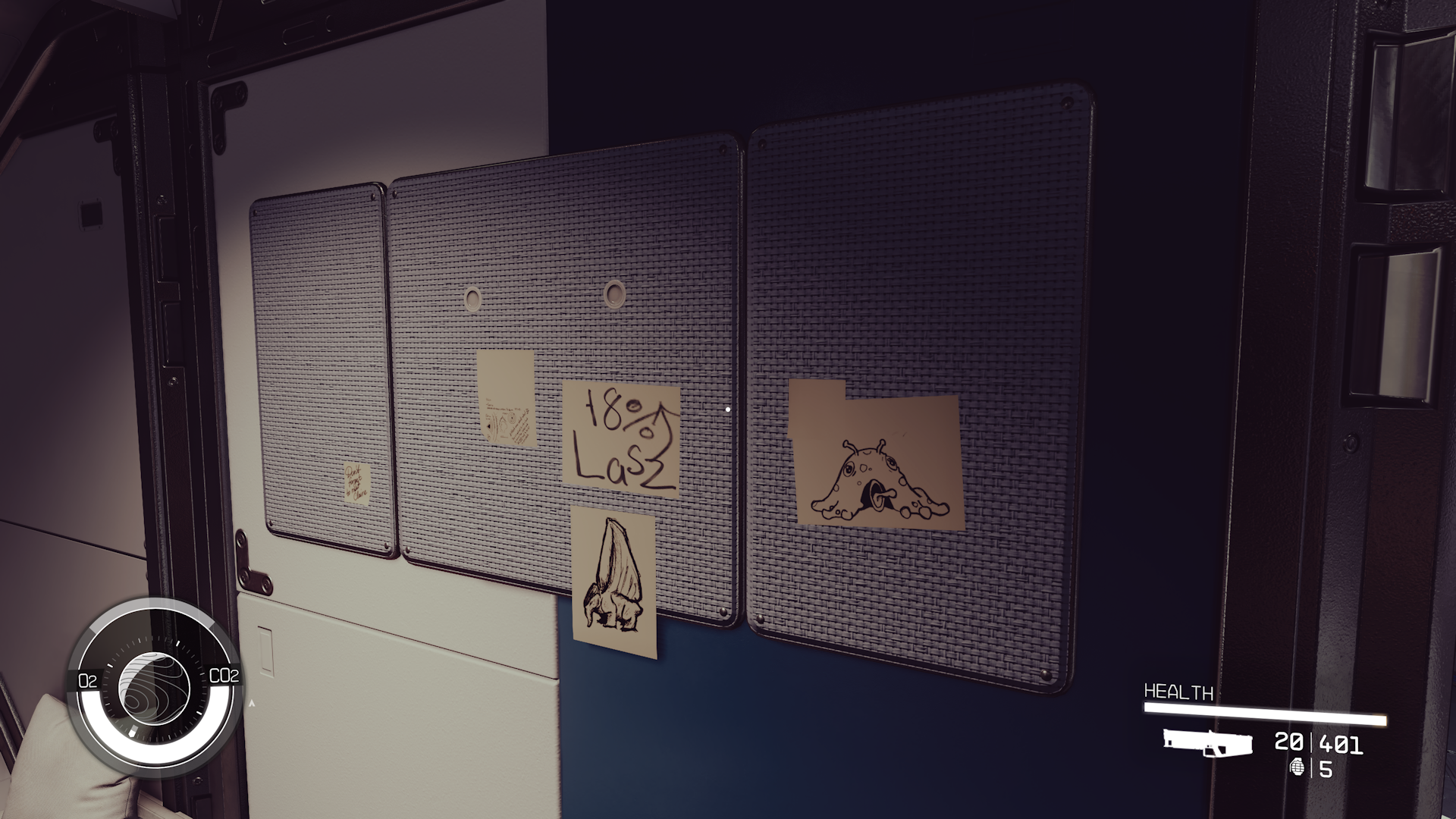
If there’s one takeaway I have from Starfield it’s this: the Creation Engine has got to go. It’s clearly no longer up to scratch, and practically every element of Starfield that I’ve singled out for criticism today is being held back by outdated software. Let Starfield be the final game to use this piece of kit, and when Bethesda shifts its focus to The Elder Scrolls VI, let’s hope that they finally retire this engine in favour of creating or licensing something more modern, and something that can really stand up to the rigours of modern game development.
Look at what other games in the RPG and action/adventure spaces are doing, and in so many ways, Starfield is being let down by its reliance on the Creation Engine. From character creation and procedural generation to graphics and bugs, the Creation Engine is showing its age and its flaws – and it’s got to go. Obviously Starfield has been made and released now, and we’ll have to deal with it as it is. But in future, Bethesda would be well-served by ending its reliance on this outdated technology.

But that’s really a question for another time! Starfield is good but not great, a game with ambitious scope that brings together a lot of different gameplay ideas – but doesn’t always make them work as well as they do elsewhere. Want more exciting space combat? Pick up Star Wars Squadrons or Elite Dangerous. Want a better, more in-depth RPG? Try Baldur’s Gate 3. Outpost building in a sci-fi setting? Something like Frostpunk or Subnautica might be up your alley. Looking for a first-person adventure? Cyberpunk 2077 or even The Outer Worlds are no less enjoyable.
This is both Starfield’s selling-point and its biggest flaw: it brings together so many different concepts that it can’t possibly deliver a suitably in-depth experience with any of them. The role-playing side of the game is let down by incredibly basic quest design that’s akin to making a few clicks on a menu. Spaceflight is let down by… not actually being able to fly anywhere in space. Shipbuilding is let down by a lack of customisation options. Exploration is let down by incredibly repetitive environments and loot as well as the feeling that you’re never the first person to go somewhere. And so on. If you find something you like in Starfield, chances are it won’t last all that long before you see how shallow it is, and how little longevity or replayability it has to offer.

I will give Starfield credit, at least in its launch version at time of writing, for not being excessively-monetised. I feel that the “premium edition” was over-sold, and that paying £35 for five days of early access was poor, but within the game itself there aren’t any microtransactions, lootboxes, premium currencies, paid mods, or any of the other AAA trappings that too many titles include these days. Maybe that’s a low bar, but it’s one Starfield happily clears. I sincerely hope that such nonsense won’t be added later on.
Starfield is a game I’d recommend, at least to some folks. If you have Game Pass it’s a no-brainer – you might as well give it a shot to see how you get on with it. And if you’ve played and enjoyed any Bethesda game in the past, chances are you’ll find something to like in Starfield, too, as the game feels very similar; the DNA of titles like Morrowind is clearly noticeable. I don’t think the “premium edition” is worth £100, though!
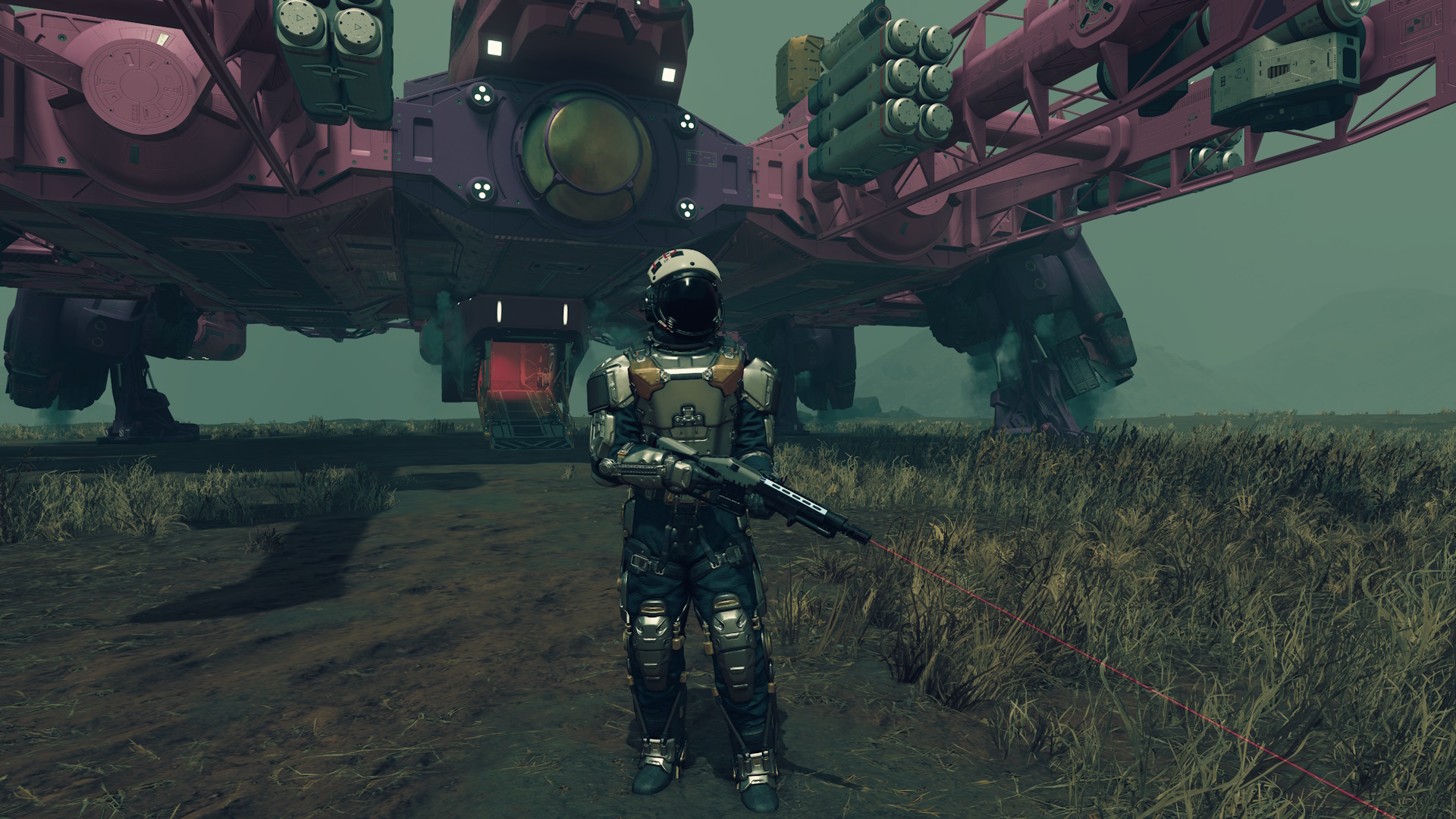
Bethesda certainly over-promised with Starfield, and lessons need to be learned on the marketing side of things to ensure the company does a better job at reining in out-of-control hype. But part of the problem lies with me – I internalised too much of the hype and excitement, and feel let down because Starfield is “just” another Bethesda open-world role-playing adventure and not the once-in-a-lifetime genre-buster that I’d hoped for. Part of that is on me, and while I have some critical thoughts about Starfield and the way it implements some of its systems and mechanics, at its core I think it’s still a decent game.
I will continue playing in the days and weeks ahead – though perhaps not every day nor with unshakable enthusiasm! If I find that I have more to say after beating the main quest or unlocking more of the game, I’ll be sure to write up my thoughts and impressions later in the year. For now, I hope this has been informative if you’re considering picking up Starfield for yourself, or at least an interesting perspective to consider. For the record, I don’t hate Starfield. I just feel a bit let down that it wasn’t all it was cracked up to be.
Starfield is out now for PC and Xbox Series S & X consoles. Starfield is the copyright of Bethesda Game Studios, Bethesda Softworks, Xbox Game Studios, and/or Microsoft. Some promo images and screenshots used above courtesy of Bethesda. This article contains the thoughts and opinions of one person only and is not intended to cause any offence.

